Dark Sun: Psionic Artifacts of Athas by oriongates
what's a TSR era book without some random tables
Original SA post Psionic Artifacts of AthasSo, I mainly reviewed Windriders of the Jagged Cliffs as a prelude to this book. You'll see why once we get to the latter half. For those who don't know, back in 2e there was a product called the Book of Artifacts, basically a big collection of the most high-powered magic items around, the kind you build campaigns around. The Book of Artifacts was, from what I recall, not too bad other than a tendency to copy-paste artifacts directly from existing campaign settings with absolutely no explanation or preparation, such as a cutlass from Spelljammer or the psychometrion, an item from Dark Sun, and an odd decision that pretty much every Artifact should have some powers that are rolled randomly. Because what's a TSR era book without some random tables?
It also had a cover featuring an excellent example of the very fine line between "awe" and "duuuurr"
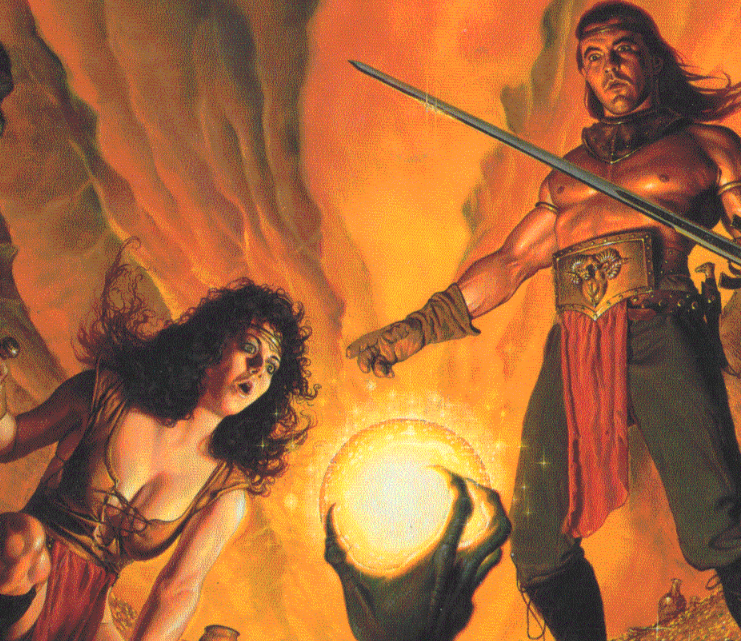
But anyway....Psionic Artifacts of Athas is basically a version of the Book of Artifacts designed exclusively for the Dark Sun setting. It's not quite clear why they felt that Dark Sun needed its own...I love the setting but the place isn't exactly overflowing with magic items. In fact a good chunk of the items are taken from the Prism Pentad novels, and most are not actually psionic. Perhaps realizing that they didn't have enough material to turn this into a full book they introduced something even weirder: life-shaped artifacts! What are those? You'll see.
Before getting into the actual contents lets take a look at this cover too and all remember the good old days when Brom did the cover art for Dark Sun. Those covers may not have always made sense, but they were cool.
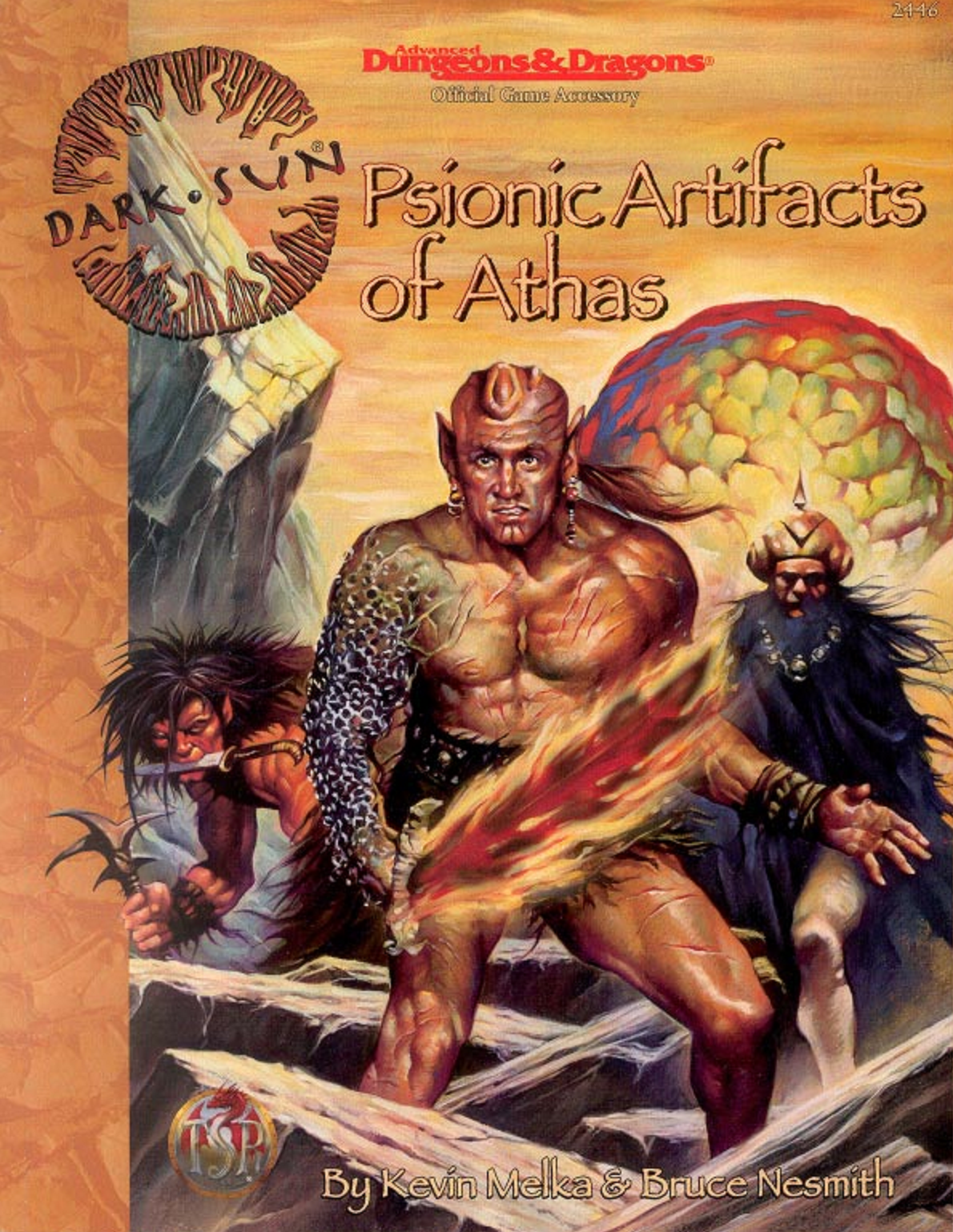
So, lets take a look at the guy on the center. After reading the book you'll realize he's actually sporting a couple of artifacts from inside...at least theoretically because its also clear the artist didn't get a great description. The flaming sword is the Schorcher (sister sword to the Silencer from the book of artifacts) and that weird looking arm is probably the Arm of Radu, Dark Sun's answer to the hand of vecna. By the way, if you're wondering what the hell is wrong with his forehead...I'm not sure either. It might be some kind of life-shaped graft, but it certainly doesn't look anything like the grafts described in the book.
The fellow on the right side is being loomed over by something that is probably the Centennial Brain and flashing us his sexy calves.
If you're wondering why the guy on the left looks so much more badass and better drawn than the other two, its because he's actually been copy-pasted from a Brom piece, the back cover for the Cerulean Storm novel.
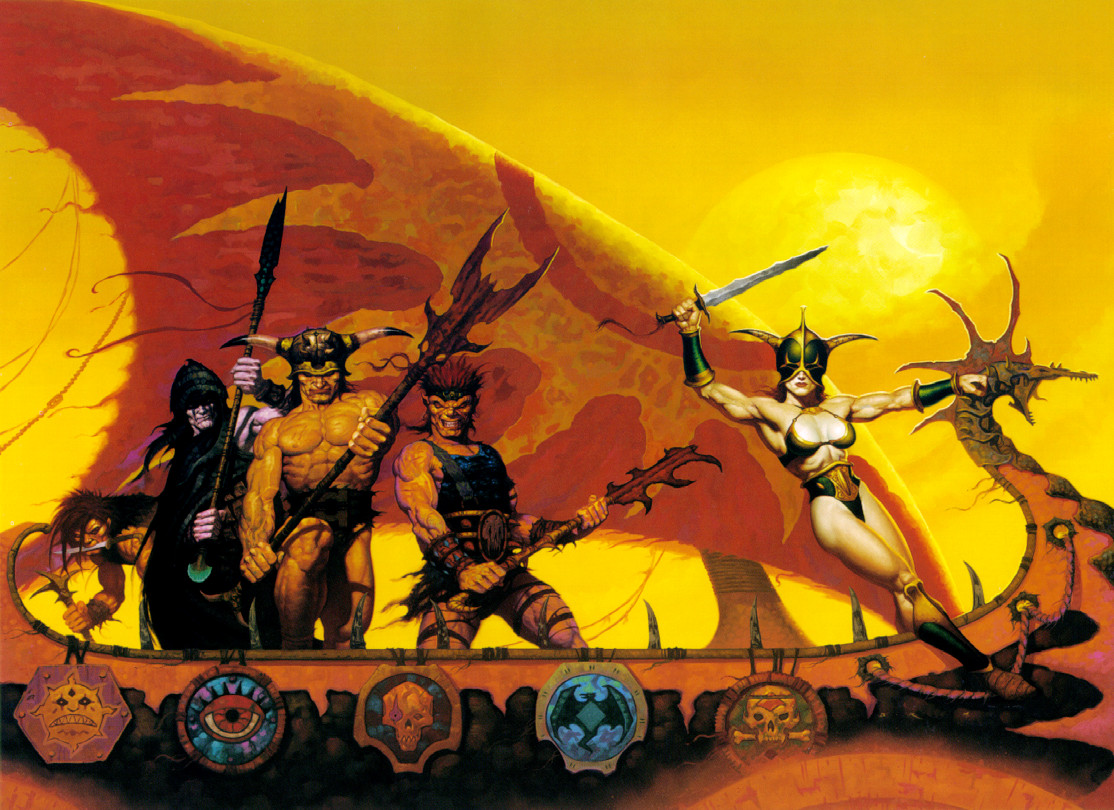
There he is, looking like the drummer in a rock band that plays weapons instead of instruments
So, lets check out the contents:
First we get an intro that tells us what artifacts are, how awesome and powerful they are, etc. It also mentions the artifacts that showed up in the Book of Artifacts: The Obsidian Man of Urik, The Silencer of Bodach, the Rod of Teeth and the Psychometrion of Nerid. It says that these artifacts were intentionally left out of this book to leave "more room" for new material. Normally this would be acceptable but actually reading the book makes it clear that its desperately hurting for actual page-count. It's only a 128 page paperback and only about 40 of those pages are dedicated to actual artifacts. It really sucks because the items in the Book of Artifacts were all very cool and flavorful and the book is desperately missing that. The Silencer in particular shares a close relationship with two of the other artifacts in the book, making its absence particularly notable.
And with that we jump into the artifacts.
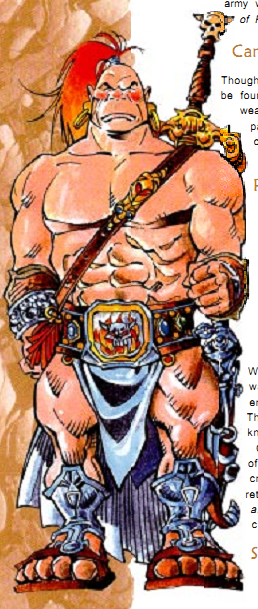
The Belt of Kings
This is basically the artifact-level version of the magic item "the Belt of Dwarvenkind". It is a big leather belt decorated with gold and silver with a scary demon-face belt-buckle. It fits anyone between a Dwarf up to a Mul and is an ancient symbol of dwarfishness in Athas, from back when Dwarves actually had their own culture and kingdoms before the Sorcerer-Kings destroyed them in the Cleansing Wars. It was created by dwarven clerics and (despite the name) commonly worn by Dwarven generals and heroes. The final rightful wearer of the belt was Rkard, the last Dwarven King who fought and was slain by, one of the Champions of Rajaat: Borys of Ebe.
The belt is from one of the Prism Pentad books where it was given to one of the main characters for a special mission and then it was returned to the Dwarves of Kled where it is guarded by the spirits of past wearers.
The belt gives any dwarf wearing it a Charisma of 18 (non-dwarves get +4 to reaction bonuses towards Dwarves...unless they stole the belt, all dwarves know instantly if the belt is stolen on sight). All non-magical missiles are drawn to its invincible belt-buckle and inflict no damage to the wearer and the wearer gets the benefits of a ring of free action. The biggest bonus is that the wearer can draw on the battle-knowledge that has accumulated in the belt. Warriors fight as though they were 4 levels higher and non-warriors fight as though they were warriors of equal level. The wearer also gains proficiency in any weapon they wish.
The belt's curse is that if the wearer ever unjustly takes the life of a dwarf the belt will immediately constrict to a diameter of 4 inches...crushing the wearer to death. Should the wearer survive or be Raised then anyone else wearing the belt will feel a compulsion to find and kill them.
To destroy the belt it must be submerged in the blood of 100 murdered dwarves.
The Dark Lens
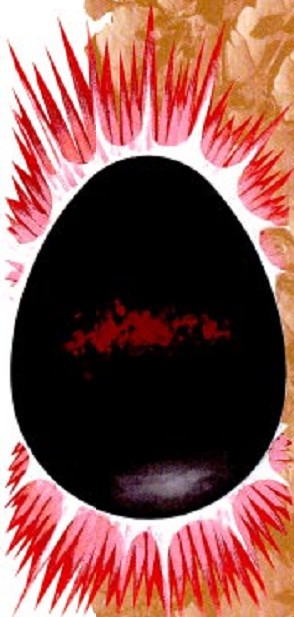
The Prism Pentad books made the Dark Lens (along with the Pristine Tower) more or less the number one most powerful artifact of Athas. The Lens is the masterpiece of Rajaat, big ugly-pants father of magic himself. The lens is a polished egg-shaped orb of obsidian described as being "about the size of a small kank". That has to be one of the least helpful descriptions ever, considering a normal-sized kank is the size of a large horse or cow. The lens apparently weighs about 170 pounds so...maybe about the size of a person? Who here knows the density of obsidian?
The raw power of the lens can be felt through intense heat that radiates from its surface. It was meant to serve as an amplifier for Rajaats massive magical and psionic powers and it was used in the creation of other powerful artifacts, namely the three swords: the Silencer, The Scourge and the Scorcher. After Rajaat's champions turned on him they used the Lens to imprison Rajaat in a pocket dimension called The Hollow.
Then apparently they put it down someplace else and had a nap because the ultimate magical artifact to end all magical artifacts was then stolen by two dwarves. Wha-wha-whaaaaa. These two dwarves somehow stole the lens out from under the nose of the most powerful beings on the planet then took it and hid it in a "crystal pit" that they created...somehow and for some reason none of the sorcerer kings felt the need to look for it. After the two dwarves died attempting to protect the lens from a tribe of giants they rose as banshees and continue to guard it after death. Then a couple more tribes of giants showed up and the dwarven banshees apparently decided that they'd trick these giants into worshipping the Lens, ensuring they would guard it. The giants called it the Oracle and protected it until it was taken by two protagonists from the novels.
Man, the Prism Pentad was pretty fucking stupid.
The Dark Lens is one of those artifacts that is just plain too powerful. I mean, that's kind of the point of artifacts but normally they're not so overwhelmingly powerful that a team of plucky heroes couldn't manage to overcome them. But the Lens is one of those that, in the hands of your enemies, means that anyone who tries to fight is doomed and in the hands of the PCs it turns everything into a cakewalk (not to mention getting the party wizard or psionicist to actually give up the thing later on).
The artifact is only usuable by psionicists (although its meant to be used by multi-classed psionicist/wizards like the Sorcerer Kings and Rajaat himself). First you have to use the psionic power contact to link with the Lens (-4 penalty) while touching the lens. Every round the user fails to make contact they suffer 1d10 damage from the heat of the lens but once contact is made the damage stops. The Lens contains 500 Psionic Power Points that can be tapped to fuel the Lens' powers and these points get restored every 24 hours. The user can also use their own PSPs to activate it should they exhaust the Lens.
The Lens acts as a Rod of Absorption and converts all magic it absorbs into PSPs (5 PSPs per level of the spell) and it lets the user use any psionic science or discipline that they know, have studied or seen used. It can also amplify magical power multiplying all elements of any spell cast through the Lens by 10. For perspective this means a 5th level wizard's fireball would inflict 50d6 damage, fill an area of 400 feet in diameter and having a range of 600 yards. Even a single Magic Missile from a first level wizard would inflict an unavoidable 10d4+10 damage. Oh, and saves against these spells are at -3.
Those with the Lens can use its powers to simply create creatures, manifesting them as an act of will. The creatures cannot have more HD than the user and have only mundane abilities: no magic or psionic powers. This can be done 3 times per day and lasts for an hour. Four times per day the user can alter their form as per Polymorph...this is indefinite unless the effect is dispelled, the user wills it to end or their psychic contact with the Lens is severed.
The Lens also has some random powers: while traveling across the silt sea the user will never be attacked by monsters, the user will not be attacked by undead and is always protected by a Mind Blank spell. Plus some actually random powers, rolled on the Immunities, Protection and Fate & Fortune.
The curse of the dark lens is a 1% per use (cumulative) that they develop meglomania, believing the lens makes them invincible (they aren't far off frankly), complete unwillingness to be separated from the lens and a possible lust for world domination.
There is no suggested means of destruction so long as the sorcerer-kings and Rajaat himself exist in any form.
Heart(s) of the Drake
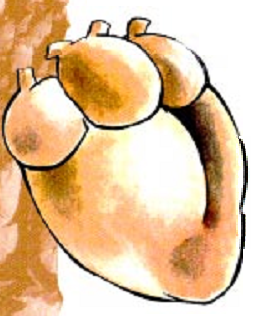
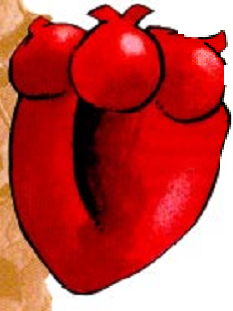
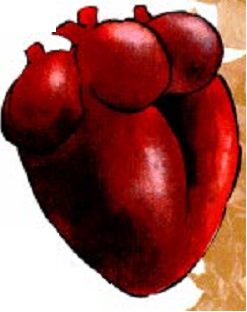
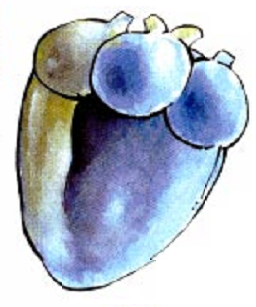
Just think, someone got paid for drawing these.
Finally, an artifact (or set in this case) that isn't somehow tied into the horrible metaplot from the Prism Pentad. The Heart of the Drake (which really should be called Hearts of the Drakes I suppose) are a set of four artifacts which are the petrified hearts of elemental drakes imbued with incredible elemental powers. Well, moderate elemental powers, they're among the least impressive artifacts.
The hearts were created by a druid about 1,000 years ago to try and defeat the sorcerer-kings. Believing that the drake's hearts contained the creature's connection to the elemental plane and the source of their power the druid spent decades hunting one of each drake species and performing a lengthy magical project to turn them into artifacts by gathering items of power and ancient pieces of elemental magic. Then he died of a heart attack at the age of 78 right when he finished. Wha-Wha-Whaaaaaah.
No one even knew about this druid's goals or his creations until a wandering elf stumbled upon the cave where he lived and pilfered everything that looked valuable (assuming the hearts to be some kind of carving). Since then the hearts have passed through the hands of nobles and collectors until a few years ago when the Fire Drake heart came into the hands of a Dwarven fire-cleric who discovered its power. She then went on a quest for the other hearts after learning of their existence. However she mysteriously disappeared shortly thereafter, along with the Fire heart.
On top of the druid's ignomious death the Hearts are not nearly strong enough to serve his purpose: they're powerful but not "topple a sorcerer-king" powerful. This isn't from the novels so it isn't allowed to kill sorcerer-kings like they were chumps.
Each heart must be activated by anointing them in a piece of their element: sprinkling the earth heart with dirt, pouring water on the water heart, putting the fire heart in a campfire, and holding the air heart aloft under the open sky. This must be done once per day to keep their powers going.
All the hearts share a power in common: while holding the heart you are invisible to elemental drakes of the heart's type so long as you do not do something to harm the drake. For some reason (probably bad editing) the Earth and Water drake hearts say the hearts make you immune to the earth and water based attacks of the corresponding drake, but the Air and Fire hearts don't have such a statement. However all other powers of the heart fail against Drakes of the heart's type. The Heart also grants +4 to saves from spells of the elemental sphere associated with the heart and allows the bearer to ignore 1s and 2s rolled from damaging spells from the sphere.
*The Air Heart grants the ability to Fly (as the spell) at will and can also go without breathing for up to 12 hours per day and once per week they can remove all air from a 10-yard radius. The vacuum lasts 10 rounds and will kill creatures inside within 1d4 rounds unless they leave. The air heart can conjure a lesser air elemental once per week, create a gust of wind 5/day and cast cloudkill 1/day. Plus three random abilities rolled on the Elemental Air chart.
The curse of the Air heart is a 1% cumulative chance per use that the user will suffer extreme pain on contact with the ground and suffering 1d10 damage per round of contact. (using the Flying ability constantly to avoid it, even while asleep)
*The Earth Heart has probably the most powerful constant ability: it can prevent wizards from drawing power from the earth within 100 yards, stopping all wizardly magic (defiler and preserver), however this requires holding the heart in your hands and concentrating on it. Spells that wizards attempt to cast are used but have no effect. It also allows the bearer to continue breathing even when buried under the ground. The Heart can be used to gate in earth, filling a 50 foot cube around the user. Anyone trapped within the cube who fails their saves is caught and is slowly crushed to death (1d12 damage a round). It's unclear how the earth-heart user is meant to cope with this. They can meld with stone 3/day, animate rock 1/day, conjure a lesser earth elemental 1/week, and transmute rock to mud 1/day. Plus 3 random powers from the Elemental Earth table.
The curse of the Earth heart is the inverse of the Air heart, 1d10 damage per round they are not in contact with the ground. This includes climbing trees and presumably being inside buildings without earthen floors. Like the Air heart there is a 1% cumulative chance per use of the heart that it starts.
*The Fire Heart acts as a ring of fire resistance and cannot be harmed by the poisonous gasses, ash or proximity heat of volcanoes. They can also create non-magical fires (size of a campfire or smaller) at will. Once per day they can gate in fire from the plane of Fire as a 7th level fire cleric. If the user is already a fire cleric their power is doubled. Once per month the heart can be used to spontaneously combust a single humaniod of half-giant size or smaller. The fire does 1d10 damage per round until the target is dead and the flames will not go out until the magic is dispelled, the heart-bearer wills it or it is doused by a spell from the water heart. This also prevents raising from the dead with anything less than a Wish. The fire heart also lets you cast Delayed Blast Fireball 1/day, fire shield 1/day and light 3 times per day, plus 3 powers rolled randomly from the Elemental Fire chart. Is it just me or is the Fire Heart a lot more useful than the others?
The curse is a 1% cumulative chance that the user loses a point of intelligence. Once their intelligence drops to 6 or less they basically have the mind and instincts of a fire-drake, seeking out a volcano to live. Despite this they recall how to use the fire heart and will use its powers to protect themselves.
*The Water Heart allows the bearer to breath underwater and act without penalty (as per helm of underwater action). They also get aquaman powers: telepathically communicating with underwater creatures who react neutrally to them. The heart also allows the user to walk on water. All of these powers are, of course, next to useless in Athas. Twice per day they can dehydrate a creature, inflicting 8d8 damage unless they are immersed in water and once per month they can create 100 gallons of fresh water. The user can also conjure a lesser elemental 1/week, cast wall of ice 1/day and reflecting pool 1/day. Plus three random powers from the Elemental Water table.
The water curse is a 1% chance per use to increase the users demand for water...5 times their normal intake! They can also never regain constitution lost to dehydration.
The suggested means of destruction is to cast each heart into a mass of the elemental (powerful volcano, into a hurricane, etc) and casting resurrection. The heart will disappear and a week later an ancient drake of the appropriate type will appear.
Next time I'll get back into some more terrible meta-plot artifacts from the first Prism Pentad novel.
Metaplot Devices
Original SA post
Psionic Artifacts of Athas part 2:
Metaplot Devices
Okay, now we've already had some metaplot artifacts, the Belt of Kings and the Dark Lens, but that's just the tip of the ice berg. Metaplot artifacts really make up the bulk of this book's non-life-shaped artifacts.

The halfling with the pink afro might be the best illustration in this book.
The Heartwood Spear
The Heartwood Spear is from the very first Prism Pentad book and it's the weapon that was essential to the killing of King Kalak.
The Spear is formed only of a single piece of wood and is perfectly smooth (no one told the artist that apparently) coming to an extremely sharp, natural point.
For some reason, the first paragraph of it's history is very vague "It is thought that this artifact was once a piece of the Last Tree, although the only person who could verify this is Nok the Halfling. However, Nok perished in the battle with Sadira while attempting to retrieve Ktando's Cane and return it to the halflings of the forest ridge." Okay, well first and foremost none of that would make any sense to someone who hadn't read at least a summary of the Prism Pentad novels...and those who have read it know very well that the spear was pulled directly from the Last Tree and given to Rikus to slay Kalak.
Oh, and then the history goes on to say just that. Nok gave the spear to Rikus once the halflings learned that King Kalak was going to turn into a dragon. We then have more metaplot: Rikus returns the spear, Nok gets mad at Sardira. They fight, Sardira wins and Nok turns the spear into a tree. That's right, this artifact effectively doesn't exist anymore! Thanks for wasting the page!
The entry goes on to say that a powerful halfling like Nok may be able to create a new Spear from the last tree or return the tree-spear back to its original form...but still, the entire artifact section is so bloated with Prism Pentad related artifacts that it seems like including one that the metaplot already destroyed is pretty wasteful.
Anyway, who does the spear actually do. It's a +5 Spear and it can ignore all armor, magical or otherwise and if it rolls maximum damage to an armored target the armor must make a save or be destroyed. Plus the bearer of the spear is immune to all nature-based magic (presumably this means druid spells?) and all psionics.
I mean, it's certainly not bad, and if used properly it could be very effective at killing a target like a Sorcerer-King (who have relatively few HP for their level being psionicist/wizards, but impressive AC due to magical defenses and natural armor). Given that it doesn't actually protect against wizard magic few would-be-assassins are likely to get very close with it (notably, in the book it originates from the Spear is specifically intended to protect against wizardry).
The suggested means of destruction (although it hardly needs it considering its now a tree) are to smash the spear against the glass of the obsidian plain or it will simply rot to pieces if it draws the blood of a halfling.
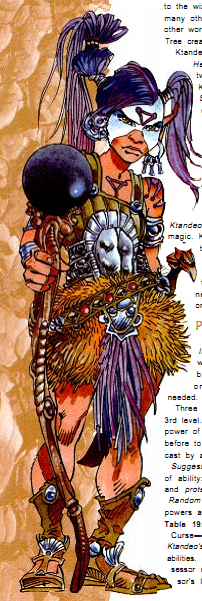
Ktandeo's Cane
I always want to spell this as Ktandeo's Kane.
So, this artifact is a complete and total disaster, but properly understanding why requires a bit of background on the Prism Pentad series, the series whose plot completely warped the setting of Athas and whose artifacts dominate this book.
It all goes back to the Verdant Passage, the first Prism Pentad novel which, I will say, isn't all that bad by the standards of cheap, licensed fantasy novels. It did a pretty good job of getting the setting right, the plot was simple but not painfully dumb or anything and the changes it introduced to the setting (the death of King Kalak and the creation of the "Free City-State" of Tyr) are minor enough to be ignored easily if you don't like them and are actually a welcome bit of variety in the standard hot bleak mess that is Athasian life. It's one of the few elements of the metaplot I have no problem with keeping in the game.
There was one area where the Verdant Passage differed significantly from the standard rules of Dark Sun, and I'll go out on a limb and say I think its actually an improvement, in that it didn't present preservers and defilers as a flat either-or dichotomy. Preservers knew how to draw magic without killing living things...but they still could defile if they wanted to (for more power) or if they had to (to cast a spell of greater power than they could normally). Honestly, I'd say that's a good thing, it makes life as a preserver more interesting and keeps things in a nice, morally ambiguous area where morality comes into question.
Now, here's where things get hinky. In the book Ktandeo was Sardira's teacher, a human preserver who often used magic with the aid of his cane a wooden staff topped with an obsidian orb. The cane was a gift from the halfling cheiftan Nok. The Cane allowed Ktandeo to draw life-energy from his own body rather than the environment, allowing him to cast spells much more powerfully than he could as a preserver without risking the destruction of nearby things. It also seems to have served as a general amplifier of magic as well, but that could have been because the magic in the books was decidedly not very Vancian.
Now, in Psionic Arifacts of Athas Ktandeo is apparently a halfling. Being a halfling he has no magical abilities and only uses the cane to cast wizard-like spells from his own life-force. Despite this he somehow is able to teach Sardira and her fellow preservers the methods for casting wizardry spells. So not only does this not really make any sense in the context of standard D&D rules it completely contradicts the book that the whole thing is based on.
It was so confusing when I re-read this that I actually looked it up and supposedly the reason for the change is that the writer of the artifact entry got confused by the art piece chosen for the entry (see above), which depicts what is clearly a young, halfling holding the cane (which makes perfect sense as the cane was a gift to Ktandeo from the halflings and their creation). Somehow, the artist got the impression that this was supposed to be sardira's elderly human mentor and due to this misinterpretation came up with an entirely different purpose for the cane, to grant the halfling the illusion of being a wizard.
Oh, and guess what, following the rest of the meta-plot-laden history we find out the cane has been shattered during Nok's fight with Sardira. Yet another destroyed artifact taking up page-count.
Anyway, so what can the cane do? It can cast wizard-y spells as spell-like abilities, duplicating any wizard spells of 3rd level or less that the user has seen, up to 3 times per day. it can also cast globe of invulnerability 1/day, hold monster 2/day, suffocate 1/week, and protection from evil 10' radius 5/day. Plus a selection of random abilities: two from Major Spell-like Powers, one from Offensive Powers, and one from Protections.
Its curse is drawing on the user's life force, aging the caster 6 months per use, 12 months per use if you use it more than 3 times per day. This is another deviation from the book, but a more understandable one given the difference in how spellcasting works. This would normally be fairly weak for most settings (an elf could use the cane all day) but Athas doesn't really have any extremely long-lived PC races.
Suggested means of destruction: broken by an item made from the Last Tree, crushed under the foot of a 20th level or higher Defiler, or broken by an elderly halfling (oh hey, that already happened).
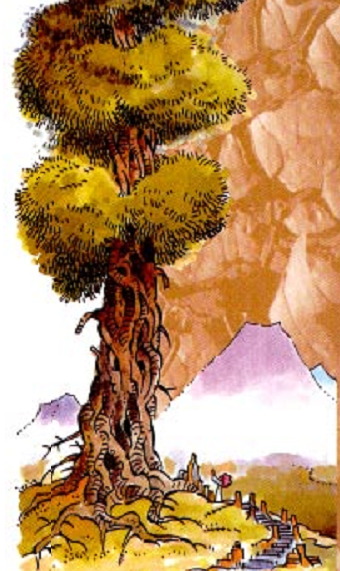
The Last Tree
Now, we've moved on from metaplot artifacts that have already been destroyed to the metaplot artifact that made them in the first place, except you probably won't be able to get it to talk to you because you're "unworthy". Judgemental racist old tree. Oh, and this racist old tree that probably won't help you have over a full page dedicated to its incredibly dull history.
The Last Tree isn't obviously actually the last tree...given its located in the Forest Ridge. However, it is a survivor of the Blue Age of Athas. It stands on the top of the highest mountain in the Forest Ridge, standing over 500 feet tall and a dozen yards wide. It's very big.
As the Blue Age was ending there was a battle between the "good" Nature Masters and the evil "Nature-Benders". The leader of the nature masters, a halfling named Sull was mortally wounded and dragged himself to the top of a mountain, spoke magic words and turned himself into a tree.
Now, you may be wondering how. No clue. Keep in mind that lifeshaping is not a form of magic. It's explicitly a scientific (very soft science, but still) process which simply involves combining the right ingredients in the right way. It, very clearly, does not involve magic words and likewise the ancient halflings did not practice magic at all, focusing exclusively on life-shaping. Now, this might be an acceptable level of vagueness given that life-shaping rules were introduced in a separate book...except that this one has an entire section dedicated to life-shaping and life-shaped creations. It probably has more material on life-shaping than the actual Windriders of the Jagged Cliffs book itself! Anyway, Sull's mind lives in the heart of the tree and is the last, true Nature Master in the world.
Around the time of the cleansing wars a badly wounded halfling hunter stumbled upon the tree and Sull decided to reach down a branch and heal him. Tired for his ordeal the halfling hunter rested at the base of the tree for a few days. Naturally the tree was fairly depressed at the quality of its descendants. After leaving the tree the hunter returned a few weeks later with his village elders, including a Rain Cleric who found the tree an object of holy awe.
For the next 2000 years rain clerics (why only rain?) from throughout the forest ridge came to the tree to speak to it and learn its wisdom. The Last Tree has shared wisdom and secrets with the halflings who come to it, the most prominent was the halfling chieftan Nok who used the Tree to create the Heartwoood Spear and Ktandeo's Cane. Of course, the halflings consider the Last Tree to be the greatest and most important secret of their people.
The last tree will communicate only with halflings and apparently has not actually decided to share any knowledge of life-shaping (although, presumably if it learned of the halflings of the Jagged Cliffs it would be quite eager to help them restore their dying knowledge). On the one hand I can understand the tree being worried about throwing life-shaping "out there"...on the other hand Athas is pretty much on its last legs and one thing Life-shaping is really good at is environmental manipulation and restoration.
The Tree is ancient but pretty much knows only about the Blue Age and life-shaping...it hasn't exactly been roaming the world.
As far as what the tree can actually do:
It can all upon chain lightning (from the mist around its branches) (twice per day) and use all the powers from the Healing and Nature tables at will. The tree is immune to psionics and to magical fire, but can be burned with normal fire (and I suppose any other sort of magical damage). It can produce 20 gallons of water per day. It's branches can produce enchanted weaponry (+1 to +5) if the tree wishes. It can also grant any of its own powers to a subject for 2d10 days.
The tree could be destroyed by the eruption of the mountain it sits on, or by preventing it from receiving sunlight for 72 hours.
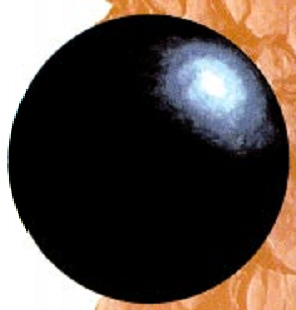
The rest look like this, but smaller
The Orbs of Kalid-ma
The Orbs of Kalid-Ma are, thankfully, not related to the metaplot and are instead a set of 5 obsidian spheres created to help one of the Sorcerer-Kings to transform into a dragon extra-fast. It's a fair bet that if a sorcerer-king dies, its because they were trying to rush their dragon-transformation in some way. The city of Kalidnay (Kalid-Ma's city-state) was destroyed in the process. Although: fun fact! It's not mentioned here but neither the city-state nor the sorcerer-king are actually destroyed. They're actually in Raveloft (having transferred there when Kalid-Ma's high priestess murdered her children to keep his botched ritual from killing him). Because when you think Gothic Horror you really think Dark Sun.
Fortunately, the book declines to go down that particular rabbit hole and presents an alternate history where Kalid-Ma actually succeeds in jumping up 5 levels in the Dragon transformation process but the effect is too much for his mind to handle, driving him insane and turning him into a ravening beast. He wrecks the city and is eventually killed by the combined efforts of three other sorcerer kings.
The orbs survived (Kalid-ma swallowed them as part of the transformation) and the sorcerer kings powers (magical and psionic) had transferred into them. There are 5 Orbs, each with a theme. The king's mind was shattered into each one, giving each an Ego score, making them capable of dominating the bearer and if all five orbs were brought together and swallowed by a pre-dragon (defiler/psionicist of 20th level or higher) then they would reconstitute Kalid-Ma, recreating him as a 27th level Dragon, with full access to his faculties once more. Even worse, the orbs combine their Ego rating when possessed by the same person (for those not familiar: you get dominated when the artifact's Ego exceeds your combined Intelligence, Charisma and Level (so once its greater than 30 most psions or wizards are probably starting to be at risk).
The orbs are:
The Protector: The smallest orb. It has an Ego of 10 and grants a constant protection from normal missiles spell and a +2 to all saves and MAC. Once per day it can function as a cube of force that lasts for one turn and gives you a random "what it protects you from" roll. This is actually a really lame power as it has really only about a 1-in-3 chance of being useful any time its used and it only lasts for 1 turn. It also grants immunity to illusions and mind blank as a constant effect and it can neutralize poison 1/day. Plus two abilities from the Immunities Table and one from Protections.
The curse of this orb is the possessor believes themselves to be invulnerable and must make a wisdom roll to act in any way to try and defend themselves...which really sucks since that includes activating any of the orb's non-constant abilities.
Orb of Minor Magic: That's a really unimpressive name. This Orb has an Ego of 18. The orb projects a constant minor globe of invulnerability and all your 1-3rd level wizard spells last twice as long. Plus you can cast Burning Hands 5/day, dancing lights 5/day, fear 3/day, sanctuary 5/day, and free action 1/day. Plus 4 random powers from the Minor Spell-like Abilities table and 1 from the Movement table.
The curse of this orb is that it pollutes all water within 30' if used. Wow, that's actually really bad in Athas.
The Confronter: This one has an Ego of 18 and is focused on offensive magic. It also enhances the user's physical abilities: +4 to damage rolls and treating 19 and 20's on attack as a double-damage critical hit. In addition, when casting a spell while holding the orb in your hand the spell's range is doubled, the duration is tripled and all 1's and 2's on damage dice are treated as 3's. Three times per day the user can get +5 to hit or reduce their THACO to 2, whichever is better, for one hour. Once per week the orb can stop time within a 30 yard radius for 1d6+1 rounds. Twice per day it can reflect attacks (physical or magical). Finally it can energy drain 1/week, cast strength 3/day, call lightning 1/week, haste 1/day, flaming sphere 5/day, and shocking grasp 5/day. Plus 3 powers from the Combat table, two from Minor spell-like abilities and one from major spell-like abilities.
The orb's time stop causes all dead creatures in the area to rise up and attack the nearest living being as standard zombies. Plus the spell-like abilities drain the surroundings as though cast by a defiler (aging the user a year if no plants are available).
The Orb of Schools: This orb has an Ego of 22, spelling trouble for most people in combination with another orb. If the possessor of the orb is a wizard then they can choose a school of magic at the start of each day and memorize two extra spells per level for that school. It also takes 1/4th the time to memorize evocation spells but three times as long to memorize illusion spells (reflecting Kalid-Ma's preferences). Once per day the user can gain a 50% magic resistance to spells of a particular school, lasting for 12 hours. They can also pick a school and a target and twice per day inflict a -3 penalty to all the target's saves against that school, lasting until the target fails a save.
It can also cast Avoidance 1/day, Merciful Shadows 7/day, aerial servant 1/week, grease 3/day, wizard eye 3/day, detect magic 3/day, charm person 2/day, wall of force 1/day, chill touch 5/day, polymorph other 3/day and weird 1/week. Plus a lot of random powers 2 from Abjurations, 2 from Conjurations, 2 from Detection, 1 from Enchantment, 1 from Major Spell-like abilities, 2 from minor spell like powers, and one from offensive powers.
The curse is a cumulative 1% chance per day of the owner gaining the arrogance of a sorcerer-king, insisting on being treated as though he were one.
The Mindbender: The largest orb, 24 inches (remember, these things were intended to be swallowed 0.o), with an Ego of 26. It is the entirity of Kalid-Ma's psionic abilities. It grants the possessor all 5 psionic attack and defense modes and a +4 to MAC and MTHACO. It also has 200 PSPs to draw from to fuel the user's powers or the powers of the orb. If the bearer is only a wild talent they gain the abilities of a 4th level psionicist (6th level for defilers) this is treated as dual or multi-classing depending on race and grants hit points and all the other benefits of the class levels. A psionicist gains 4 levels of experience from the orb (6 levels if they are a multi-class defiler/psionicist). All these bonuses are lost if the orb is.
The possessor of the orb can choose to ignore the effect of one psionic discipline once per day for 12 hours. Twice per day the bearer can reflect a psionic attack back to the source and twice per day they can inflict -5 to someone's MTHACO which lasts until the victim succeeds at a roll. It also grants the powers of detect psionics 3/day, know direction at will, displacement for 1 hour 1/day, see magic at will, inflict pain at will, true sight for 1 turn 1/hour, life draining for 1 turn 2/day and ultrablast 1/week and a permanent mind blank effect.
And of course random powers!! one from Detection, four from Psionic Devotions, three from Psionic Sciences, and one from Protections. The curse is a 1% cumulative chance per day that the bearer ignores their primary class in favor of psionics. If they are defiler this has no effect, if they are a preserver then they will turn towards defiling. They don't just neglect their current class...they lose all levels in it, becoming a pure psionicist or a multiclass psionicist/defiler. If they ever lose the orb they lose all psionic abilities it granted them...which may leave them as a 0 level character.
If you have multiple orbs you get additional benefits, but they're all from random tables and I'm so tired of typing those out. Suffice it to say: more random spell-like abilities the more orbs you have. Of course once you've got 4 or more orbs the ego score is at a minimum of 68, meaning that there is no chance of a character resisting domination
suggested means of destruction: shatter the orbs against the walls of the Pristine Tower, strike the orbs with Tari bone (the race kalidma was to exterminate), cover them in the blood of two sorcerer kings, drop all five into a cauldron of boiling gold.
Thats it for now, next time we'll get some slightly more interesting artifacts
Slightly More Interesting Artifacts
Original SA post
Psionic Artifacts of Athas part 3:
Slightly More Interesting Artifacts
Now we're almost done with meta-plot junk (There's still the Scourge of Rkard but at least that's a respectable magic sword) so lets get on with the artifacts!
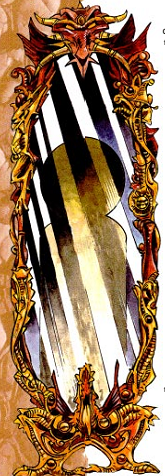
The Planar Gate
Guess what, in this book, this is the first actual psionic artifact and it is one of only two psionic artifacts. That's right, in a book titled "Psionic Artifacts of Athas" there are only two actual psionic artifacts. There's a couple more artifacts that have psionic effects (the Dark Lens or the Mindbender Orb) but they're still explicitly magical artifacts that interact with psionics.
The Planar Gate is something that wouldn't be very impressive outside of Athas. You see as the "Multiverse" of D&D became more interconnected via series like Planescape and Spelljammer the differences in Athas became a bit starker...why didn't it have any Gods when they're everywhere in the rest of the universe, why don't the Sorcerer-Kings just open up doors to nicer places and leave this ruined world behind? Why does their magic kill plants?
Well, apparently not linking Athas to the rest of the multiverse was just unthinkable so the explanation became that Athas was simply cut off...its crystal sphere is completely impermeable, totally blocking Athas from Spelljamming and the Outer Planes are "insulated" from Athas by a demi-plane unique to Dark Sun called "The Black", sort of a poor-man's Plane of Shadows, and the souls of the dead in Dark Sun go to another demi-plane called The Gray, which also serves the function of the Ethereal Plane. As a result, spells that communicate with or reach out to the Outer Planes are extraordinarily difficult to pull off, to the degree that most mages, priests and psionicists don't even realize these other planes exist.
The Planar Gate was designed by master psionicists of the Green Age who did learn of the Outer Planes and had a desire to learn more about them. The Gate resembles a giant mirror and was constructed by the city of Giustenal, before the city was sacked by the sorcerer-king Dregoth. When Dregoth was slain by his fellow sorcerer-kings to keep him from completing his transformation into a true dragon and returned to life as an undead, he continued to use the mirror (hidden in the caverns below Giustenal) as a research tool. Having learned about the truth of the Outer Planes and the other worlds in the Material Plane Dregoth has learned about the existence of true gods and seeks to transform himself into one (something that is fortunately impossible in Athas).
The Gate is sentient, possessing an artificially created psionic intelligence to control its powers and generate its own psionic power points...well, in theory because the book never says how many PSPs the gate actually has! This is pretty important since the Gate uses up one PSP per round to keep itself focused once a destination has been "set"...so I guess the Gate can display an image for anywhere from a few minutes to....maybe an hour (assuming it has more PSPs than the Dark Lens itself). A PSP per round doesn't give you a lot of time. The Gate has an INT of 15 and can speak psionically in the languages of the ancient Green Age and the language of old Giustenal. It's not one for idle talk but it has no problem explaining its function and purpose to those who ask. The Gate is neutrally aligned and doesn't judge those who use it, as far as its concerned serving Dregoth is perfectly fine. However, it does see itself as purely a tool of learning and research and will refuse to help someone pursue acts of true evil or conquest (something Dregoth has carefully avoided).
To actually get the Gate to focus you've got to use the Clairvoyance power (using your own PSPs) and maintain the power yourself until the gate successfully zeroes in on the plane you want. If its a plane the Gate knows already then you can ask the Gate to find it for you (which takes 1d6+1 rounds) but if you're trying to find a plane the Gate doesn't know about then you have to pick a number between 1 and 100 then keep rolling 1d100 each round until you hit the number you picked (paying the cost to maintain your clairvoyance power each round).
Once its focused you can use the Probability Travel psionic power to use the Gate as a portal to the plane in question. Again, you pay the cost in PSPs yourself. Once you're through the gate you can see the return portal as a shimmering light that is invisible to everyone else and can use Probability Travel again to go back through. Of course, if the Planar Gate runs out of PSPs then you're effectively trapped in the other plane and probably can't get back to Athas (although odds are good you're "stranded" somewhere nicer). Which makes the fact that they completely forgot to tell us how many PSPs the gate has even more important. 100 PSPs means the gate only holds for 10 minutes...so even if the gate has twice as many PSPs at the Dark Lens it could only stay open about an hour and 40 minutes.
Oh, and there are also absolutely no rules for "targeting" the Gate...considering the other Planes are infinite and all the benefits of gating back and forth are pretty limited if you can't control where you'll end up. I wouldn't be surprised if the ancient researcher notes on the Gate pretty much consist of things like "Plane # 5: looks like a nice field, I saw a rabbit." and "Plane #2: looks like a horrible place, lots of pointy things in the distance. I think I saw a bird, but you know an evil bird."
The Gate has no powers or functions beyond that.
The Gate is also exceptionally easy to destroy. It can simply be broken (AC 2, 100 HP) with ordinary attacks. It'll explode violently (10d10 damage within 100 yards) if targeted with an actual Gate spell, and it'll destroy itself if it finds its been used for evil or destructive purposes.
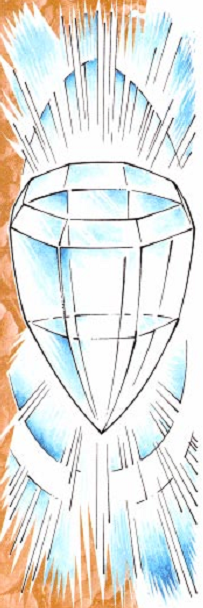
The Psionatrix
The second actual psionic artifact and another creation of the Green Age. There's a line in the description claiming that it is a "fusion of magic and psionics", like the Dark Lens but not only does it have no magical abilities it also predates Rajaat, meaning magic didn't exist when it was created.
The Psionatrix is pretty much exactly what you might think: it's a powerful source of psionic abilities and power points. It featured in an adventure called Dragon's Crown where a powerful psionicist amplified one of the Psionatrix's powers to suppress psionic abilities (its not clear why) and at the end the psionatrix gets destroyed by a magic item called the water hammer. Yet another wrecked artifact...at least the Psionatrix isn't completely wrecked: its largest shard retains a fraction of its former power. But still, almost half of these artifacts have already been destroyed!
The original Psionatrix provides unlimited PSPs to anyone in contact with it and access to all psionic attack and defense modes. It also doubles the range of all psionic powers. and "all MAC scores are halved for chances of success" I can honestly say I have no idea what that means. I know what MAC is...but its just like normal AC in second edition ranging from 10 to -10...what does "halving" your MAC mean? Once per day it can inhibit psionic powers within 1 mile, quadrupling the cost of all psionic powers and "all MAC rolls are doubled" Again, I don't know what that means...there's no such thing as a MAC roll and even if there was how would "doubling" the roll work...that's...that's just not how any rules in D&D work. The psionic dampening effect also drives Thri-kreen into a primal state, shutting off their higher mental functions and reducing them to mindless pack hunters.
The psionatrix also provides some psionic powers: all around vision constantly, blink 3/day, displacement for one hour 1/day, project force 1/day and protection from magic for one hour 1/day. Plus three random Powers from Psionic Devotions, one from Psionic Sciences and one from Protections.
The lesser version contains a reservoir of 100 PSPs every day, and gets access to Ego Whip and Mind Blank. Its dampening field is much weaker, only 100 yards wide and lasting 1d2+2 minutes. It triples the cost of all psionic powers and is merely uncomfortable for thri-kreen. It still grants All-round vision, blink 3/day, displacement for one hour 1/day, and protection from magic for one hour 1/day. It gets two random powers from Devotions and one from Protections.
The only way to destroy the psionatrix is with the Water Hammer (no information on what the hammer does beyond that), which will reduce the original version to the lesser version and destroy the lesser version completely.

The Scorcher
And now we come to the sister blade of the (much cooler) Silencer of Bodach. Just like the Silencer the Scorcher was Rajaat as a gift to one of his Champions: Myron the Troll Scorcher. The sword is made from an unidentifiable red metal and the handle is wrapped in the hide of an ancient fire drake and a a tooth from that same drake adorns it. Black flames wrap the sword when wielded in combat.
Myron, the bearer of the Scorcher apparently betrayed Rajaat, questioning his purpose in the Cleansing Wars. Rajaat discovered Myron's treachery and killed him, recruiting Hamanu to replace him. After Rajaat was killed Hamanu kept the Scorcher until Dregoth started showing signs of completing his dragon transformation. Unwilling to deal with two all powerful Dragons the lesser sorcerer-kings gathered to slay him. The Scorcher was used to strike the killing blow against Dregoth. Apparently the rest of the sorcerer-kings got worried by just how powerful the Scorcher was too so they had it cast into the Silt Sea and erased it from history. The sword stayed at the bottom of the silt sea for centuries until it was swallowed by a silt horror, which was subsequently killed and the blade retrieved by an ex-gladiator.
The Scorcher isn't sentient but it is eager to serve a purpose, for good or evil. If it is in the possession of someone who doesn't have a driving purpose then it will conveniently become lost or it will call to those within 30 miles who might make use of it.
The sword is a +3 longsword but if it is wielded by someone with a Strength of 17 or more it has the speed of a short sword. It also inflicts an additional 1d4 damage from the black flames if it hits its target. The bearer of the Scorcher has immunity to mind altering spells and imposes a -5 to MTHACO rolls for mind-altering psionics. It also grants immunity to fire. It also completely ignores magical defenses, which makes it (like the Heartwood Spear) one of the best tools for busting through the magical defenses of sorcerer-kings.
The sword also has special powers depending on the alignment of the wielder. Lawful owners can treat the sword as a Vorpal weapon, neutral owners can treat it as a sword of wounding and chaotic owners treat it as a sword of sharpness. It also can slay living against an opponent struck 1/week, blur constantly while being held, true seeing 1/day, wall of fire 1/day, cast cure serious wounds on the wielder 3/day, and a constant protection from both good and evil.
Its curse is that the wielder of the sword remains fixated on their purpose (no rules are provided for this) and each wielder is subject to a different, random curse from the Curses table. For perspective this can range from "goofy" curses like swapping gender or suffering deafness so people have to shout to be heard to awful ones like terminal diseases or progressive total amnesia.
Suggested means of destruction are shattering the Scorcher against the Silencer or feeding the blade to a water drake.

Scourge of Rkard
The Scourge of Rkard is the younger sibling to the Scorcher and the Silencer...and its a metaplot item! The Scourge was made for the Dragon himself, Borys of Ebe. The name came from when Borys overthrew Rkard, the last Dwarven king (and the last bearer of the Belt of Kings). Somehow Borys lost the Scourge (what the hell is with the Champions and completely forgetting they are the frigging masters of magic and not remembering how to cast a simple spell to find the all-powerful artifacts they keep misplacing?)
The sword was apparently being kept by the dwarves of the village of Kemelok, who are also the keepers of the Belt of Kings. During one of the less memorable Prism Pentad books Rikus was lent the Belt of Kings and the Scourge to fight the armies of Urik. At the end of the battle he returned the belt to the dwarves but was allowed to keep the Scourge. At the climax of the Prism Pentad series Rikus is locked in battle with Borys, the Dragon. During the fight the Scourge snaps in half at which point it inexplicably begins to ooze a black substance which conveniently kills Borys.
That's right, yet another god-damn artifact that is already destroyed!!!
Oh well...at least this one comes with rules for actually fixing it.
The Scourge is (or was I guess) a two-handed bastard sword +4 (+6 vs sorcerer-kings) which can be used one-handed if you have a Strength of 20 or higher. It can also damage creatures from the Shadow World (I guess they mean the Black, there is nothing in Athas called "the shadow world) and inflicts double damage to them. It acts as a vorpal weapon and cuts through any wood without effort and any obsidian weapon it touches will shatter (magical ones get a save).
It also enhances the bearers hearing...for some reason. It gives an increase of about 100 times normal, allowing you to hear sounds up to a mile away.
If the sword is broken its two pieces will leak black ichor which consumes whatever they come into contact with, it is only possible to stop this by burning the ichor away if done within a minute of exposure. If the pieces of the sword are held together for a month they'll mend themselves.
The sword can be used to inspire allies, granting a +2 to hit/damage and saves for one battle or until the wielder falls in battle. This can be done once per day. It also functions as a +2 ring of protection while held and makes the wielder immune to poison.
The curse of the sword is is that if the wielder ever comes into contact with any of the other sorcerer-kings they must make a Save at -5 to avoid just attacking them outright and fight them to the death (to the wielders death, since the Scourge has none of the impressive defenses or offensive abilities of the Scorcher or the Heartwood spear). Additionally if the Scourge ever is used to slay a dwarf again its original purpose: the death of dwarves, will be revived. For each dwarf the wielder slays there is a 5% cumulative chance that the wielder will start a crusade of extermination against the dwarven race.
suggested means of destruction are to bathe it in the waters of Rajaat (who's water now). Place it in the bottom of the Silt Sea for a decade (that's...pretty easy) or have it melted down by a pure-hearted dwarf.
And there we go that is all the full-fledged artifacts in the book! After this is an incredibly dull few pages of randomly generated Powers. I'll spare you them and instead I think I'll give a summary on some of the things the book should have included, the much better written Artifacts from the Book of Artifacts: the Silencer, the Psychometron, the Obsidian Man and the Rod of Teeth.
A Brief Interlude
Original SA post
Psionic Artifacts of Athas part 3:
A Brief Interlude
So, I mentioned at the start of the review that Psionic Artifacts of Athas is basically a setting specific version of the more general Book of Artifacts, just a bit more schizophrenic and with a lot of lamer, mostly destroyed artifacts. So in the interest of sharing some actually good artifacts of Athas, I figured I'd go ahead and include the artifacts from the Book of Artifacts that come from the Dark Sun setting.
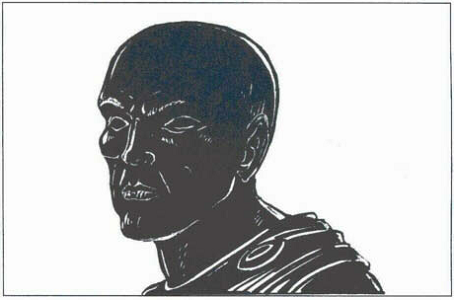
The Obsidian Man Of Urik
The Obsidian Man is a statue of pure obsidian in the shape of a man dressed like a nobleman. The statue is 12 feet tall and perfectly shaped and proportioned with no signs of chisel-marks or tools...the surface is perfectly smooth.
The statue was discovered in an obsidian mine in the Smoking Crown mountains when miners came upon the figure buried in a seam of black glass. They chipped away until they managed to completely unearth the statue, under orders from the templar in charge of the mine, and loaded it up to transport to Urik and present it to king Hamanu. However, the journey would last several days and the first night they stopped and in the morning they found 13 people gruesomely crushed to death during the night. The templars were too eager to deliver the statue to the king so they decided to push on. Every night more men were murdered. Naturally the templars suspected the statue, especially since its guards were among the ones killed, but each morning it was back in its place, unmoving. Dozens of people died during the journey.
Finally the Obsidian Man was brought to Hamanu who examined the figure for several hours...ultimately unable to discover anything he retired for the night in frustration, leaving 20 half giants to guard the statue and went to his library to research the matter. However, in the middle of the night he was disturbed by the sound of battle. He rushed out just in time to see the entire guard defeated and the gates of his palace smashed open. He followed the trail of the Obsidian Man, encountering it in the middle of the city where the two did battle. Eventually, badly wounded, the sorcerer-king finally defeated the Obsidian Man and created a golden circlet to bind it to his will.
With experimentation Hamanu discovered the Obsidian Man had several unusual powers but he never could find any clue to its origin or nature. He also learned that daylight rendered the Man immobile and powerless.
Seven years ago a young templar (for reasons unknown) removed the circlet from the Obsidian Man's brow and was immediately killed. The statue escaped the city, walking out into the desert and disappearing. Two years ago the golden circlet itself was stolen from king Hamanu's palace. The thief was never caught and no sign of the circlet has been seen since.
You see, that's a good artifact background, mysterious, intriguing and not just another "Rajaat or a Sorcerer-King made this". Something even one of the sorcerer-kings finds mysterious and dangerous is a good sign as well.
The Obsidian Man is mainly a kind of super-golem. It has 150 hp, AC -5, gets two attacks per round (THACO 5) and inflicts 5d12 damage per hit. It's movement rate is 15 and it has a strength of 25. It can only be harmed by metal weapons of +3 or greater enchantment. It is immune to all psionics except psychokinetics, and all magic except for cone of cold, Stone Shape(which does 1hp of damage per level), and Stone To Flesh (which sets the Man's AC to 10 for one round only). All of its saves are as a 20th level fighter. Reducing its hp to zero does not destroy it, merely making it inert until the next night at which point it reanimates with full hp.
In addition it can Fly on command for one hour per day. It can also create a wall of fire once per day that lasts an hour. It can stone shape by touch and cast passwall at will. It also has a ranged attack, a beam of black fire that inflicts a flat 25 points of damage (save for half) and a 60 yard range. Finally, it can cast finger of death once per week.
The curse of the obsidian man is that its a mindless killing machine who obeys no orders. The golden circlet can control it, but even with that it must be allowed to kill a sentient being every night or it will turn on its controller. It also drains the life of the user if commanded to use an invoked power, permanently draining 1 hp.
suggested means of destruction are exposure to 24 hours of continuous sunlight or cutting out its heart with a +5 weapon and throwing it into the lava of the smoking crown mountains.
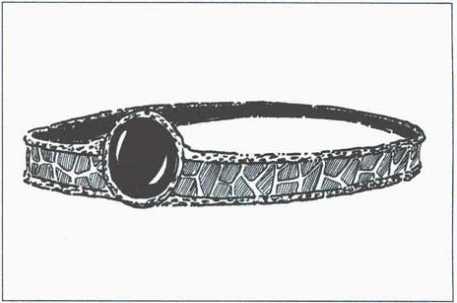
The Psychometron of Nerad
The Psychometron is a small clear gem about an inch in diameter, mounted in a headband of gold and leather.
The creator of the Psychometron is Nerad the Wise, the first preserver to attempt an Avangion transformation. Unfortunately he was not as secretive as he should have been and the Dragon hunted him down. Anticipating his defeat Nerad gave his most valuable possession, the Psychometron, to one of his retainers and instructed her to flee with it. The woman took the circlet to a community of Villichi in the Tablelands in order to seek aid and shelter. Since then the Villichi have used it to defend themselves in times of need (if you aren't familiar, the Villichi are a society of albino psychic amazons).
The Psychometron grants a +2 to saves and all power scores for telepathy and metapsionics. It also contains 150 PSPs (which regenerate at 25 per hour), It also radiates nondetection and blocks all attempts to scry or locate the owner psionically or magically.
If the Psychometron is within the radius of a defiling effect it sacrifices 1 PSP per yard to keep the defiler magic from destroying the area. This doesn't stop the spell, just the defiling side effect. It also includes the following psionic abilities which can be fueled by its own PSPs or the PSPs of the wearer: aura sight, aversion, awe, complete healing, contact, displacement, energy containment, mind bar, mind link, radial navigation and teleport.
The curse of the Psychometron is fairly mild, it is imbued with Nerad's personality and drives, leading to artifact possession. Victims become driven to end slavery and oppression, the rule of the sorcerer-kings in particular.
Suggested means of destruction are feeding it to an Earth Drake or keeping light from touching it for 99 years.
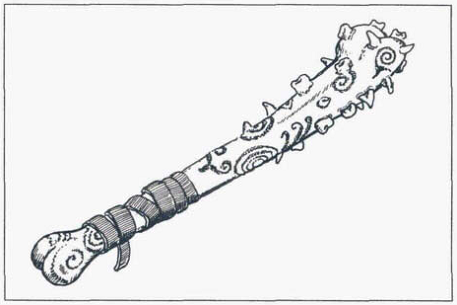
The Rod of Teeth
This is a bone club studded with human teeth and covered in strange runes and symbols. It is a relatively minor, but interesting, artifact.
The Rod was carved by a defiler named Atlak-Ta, the fetish keeper of Lalai-Puy, sorcerer-queen of Gulg over 600 years ago. It was passed on to his apprentice and since then has moved through the hands of several powerful defilers over the years.
The rod is treated as a Rod of Absorption, able to store one spell-level per tooth in the rod (currently 33). However, whenever a charge is used there is a 10% chance a tooth falls out. It also functions as a +2 weapon (inflicting 1d8+2 damage) and grants its bearer a +2 to saves against necromancy.
In addition, a wizard struck by the rod must save Vs spells or lose 1d6 spells (highest first) which are transferred to the wielder who can cast them as though they were a wizard (or if they are a wizard, they're added to their currently memorized spells).
The curse of the rod is that anyone using it has their alignment eventually shifted to chaotic evil. Every time it is used there is a 5% chance that the rod actually steals the entire mind of the wizard, not just their spells. The struck wizard's mind replaces the rod-wielders and killing the original body. The new entity has the physical stats of the rod wielder and the mental traits and class abilities of the victim.
leads to an interesting possibility of an evil wizard or psionicist intentionally allowing a powerful minion (like a half giant) to beat them with the rod until they mind swap.
The rod becomes powerless once it loses all of its teeth or returning all the teeth to their original bodies.
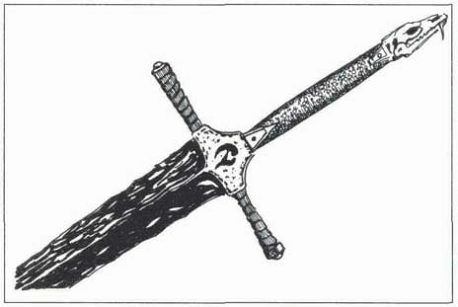
The Silencer Of Bodach
My personal favorite artifact, even if it is a "Rajaat made this" artifact. Also, let me say the really nice, clean black and white art of the book of artifacts really puts the wobbly, cartoony work in the Psionic Artifacts of Athas book to shame.
The Silencer is a 7 foot long, 7 inch wide sword made from the same red metal as the Scorcher. During the cleansing wars the silencer was crafted for Irikos, the "left hand of Rajaat" and got it's name from the city of Bodach. Bodach was an extremely powerful "neutral city" during the Cleansing Wars. Using the sword, Irikos slew the armies of Bodach and sacked the city...however the wizards of Bodach worked together to cast a powerful spell, killing both themselves and Irikos. Only the silencer itself survived.
The weapon was found in the ruins of bodach by an adventurer who used it to gather an army of raiders and bandits. However, she overstepped herself and engaged in a full-on assault of the city of Balic. The sorcerer king and his armies slaughtered the desert savages. The sword was carried away into the desert by one of her lieutenants.
The Silencer is a +5 Two Handed Sword which can be used one-handed like a longsword. It also cuts through any non-metal substance without resistance, ignoring non-metal armor and even carving through solid stone at 10 feet per round. It also grants its owner a +2 AC bonus.
It can be swung in huge arcs to magically attack everyone (-4 penalty) within a 10 foot radius. three times per day it can project a bolt of force which, if it strikes the ground or a building, acts as the earthquake spell. if it strikes a creature it inflicts 5d10 damage. And 3 times per day it can protect its owner with a Tower of Iron Will. Plus 3 random abilities from enchantment, and one from protection.
The curse is bloodlust, every day the weilder must make a save or lose a point of wisdom. and it inflicts artifact possession, driving the wielder to acts of violence and conquest...plus a fanatical loyalty to Rajaat.
That's it for this interlude, back to the main book with the next post.
Life Shaped Items
Original SA post
Psionic Artifacts of Athas part 5:
Life Shaped Items
So, as I mentioned we are at the end of the traditional artifacts in the book already (including the mere 2 actual psionic artifacts). Next we've got 15 solid pages of random artifact power charts. Because 2nd edition.
I won't bother you with the details on the tables, suffice it to say that its mostly dull lists of spell-like abilities usable X times/Y.
After that we reach Chapter 2: Life Shaped Items. That's Items, not artifacts. These are just standard, halfling-made life-shaped creatures (although mixed in are several of the items that were previously referred to as rhulhisti artifacts: life-shaped objects that can't be recreated).
The chapter starts with a bit of a dumbed down introduction to the history of life-shaping similar to the contents of the Windriders of the Jagged Cliffs book.
Really, this whole section comes off as something like errata for the rules from Windriders of the Jagged Cliffs as it doesn't mention several very unpleasant rules that came up in Windriders. For instance, life-shaped weapons and armor apparently don't suffer damage from use. Most life-shaped items now have a "dormant" stage where they can last for centuries without feeding or care. There's one big problem: at no point are these differences actually addressed. They seem unwilling to come right out and say "hey, the life-shaped items we originally made were way more trouble than they were worth, here are better rules for making them more playable." Instead they vaguely say:

The goal seems to be to create the opportunity for life-shaped items or creatures to appear as loot. On the one hand re-enacting scenes from Alien with weird, horrifying life-shaped creatures isn't a bad goal...on the other hand the idea of life-shaped "loot" is kind of laughable considering the care and feeding that they still require (including cahm-rahn for most of them). Even more laughable is the claim that life-shaped creatures have "evolved" in the wild since the Wind-riders of the Jagged Cliffs books makes it very clear that the life-shaped are completely incapable of living independent lives for a full generation, let alone actually evolving on their own. Of course, this problem could be easily solved by saying that the original life-shaped creations were capable of breeding, feeding themselves, etc and that the life-shaped of the Jagged Cliffs are inferior versions that depend on purified nutrient solution and oxygenated fluid baths because the Jagged Cliffs halflings are shitty life-shapers (or have intentionally sabotaged the process to keep the life-shaper's monopoly). But the book doesn't seem willing to address that.
There's a few pages on how you can try and incorporate the life-shaped into regular Dark Sun adventures in the Tyr Region and then we get into a big list of life-shaped items. Many of them are duplicates of items from the Jagged Cliffs book but with odd differences. For instance, arm-blades do 1d6 damage instead of 1d8 (making them just short swords that are tough to put down) and has only 1 HD. In fact almost everything has 1 HD or less. Presumably they didn't feel the need to make them so tough since they won't be taking damage with every blow anymore. Of course, the "AoE vs Lifeshaped" rule has not been mentioned at all...so presumably a single area-of-effect spell is death for all lifeshaped now rather than simply most.
I won't re-post every single life-shaped object, but here are some of the more interesting ones that aren't simply re-prints.

This is a parasitic life-shaped item...essentially the life-shaped equivalent of a "cursed" item. Note that although it says that the host has two rounds to try and pull it off before it burrows into his flesh...but it doesn't provide any suggestions on how that should be handled mechanically. I guess just stabbing it could work.
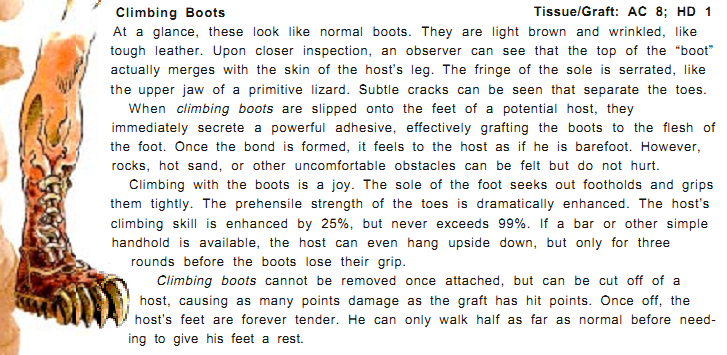
While most of the re-printed life-shaped items are fairly similar with a few numbers changed the Climbing Boots are very different. These boots are actual grafts that clamp onto your feet and never let go. They can only be cut off and no rules are provided for what happens if the boots die of old age, disease or some other circumstances. The upside is that they provide a much bigger climbing bonus (+25% vs +5%) and let you do things like hang upside down by your feet.
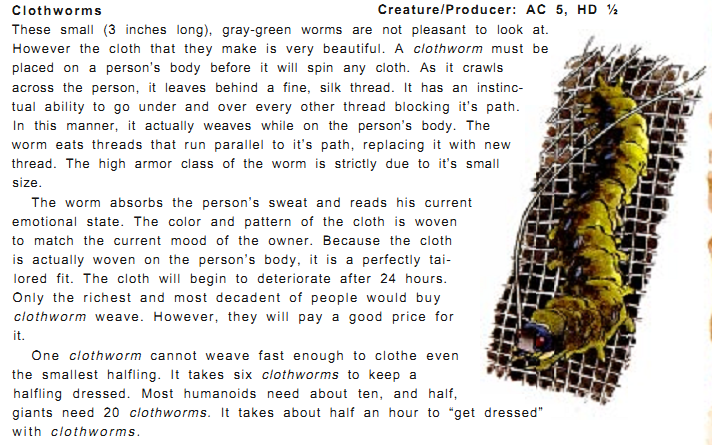
This is probably one of the worst life-shaped things ever without being an actual parasite. It takes 6 clothworms an hour of crawling over your entire body to produce a suit that (being woven directly on top of your flesh) is basically skintight and which is woven to match your current mood (generally a bad thing...why would you want clothing that tells everyone around you how you're feeling?) and decays off of your body within 24 hours. I'm not even sure how you'd be able to easily remove the clothing from your body...do you just let it rot until you're naked?
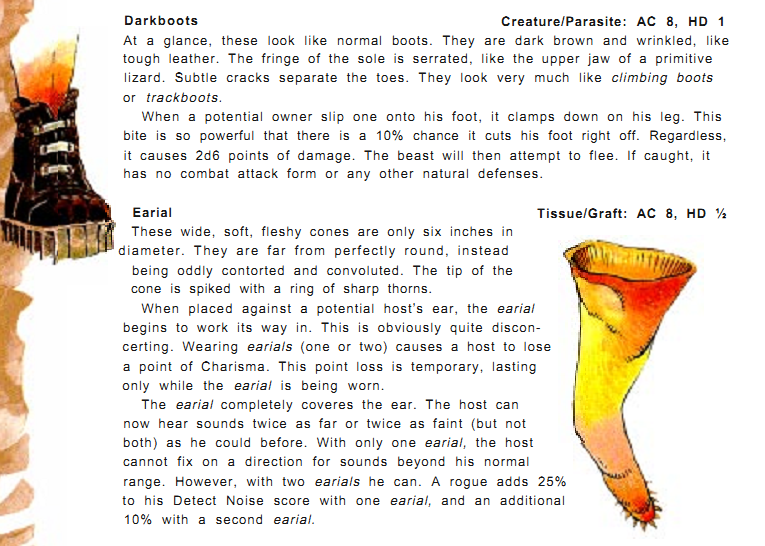
Darkboots are another parasitic life-shaped. What's ridiculous about them is after biting down on your foot they apparently attempt to flee. How?
The Earial just sounds painful. And apparently wearing one costs a point of charisma...keep in mind that having a sword attached to your fore-arm, weaving grubs crawling all over you or a tail doesn't hurt your charisma...but people just can't stand weird-looking ears.

That guy seems oddly chill about it.
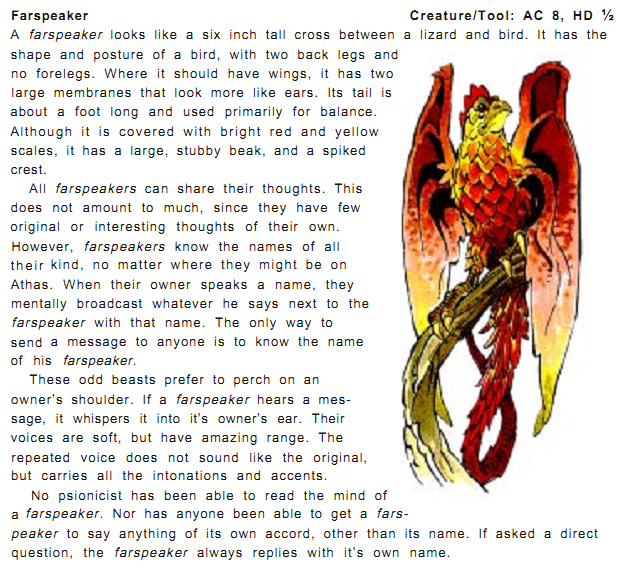
This is one of those cases where the writers seem to forget that life-shaping isn't actually supposed to be magical. Lifeshaping specifically predates magic and psionics...so how the hell do Farspeakers talk mind-to-mind? And why are they immune to psionic mind-reading?
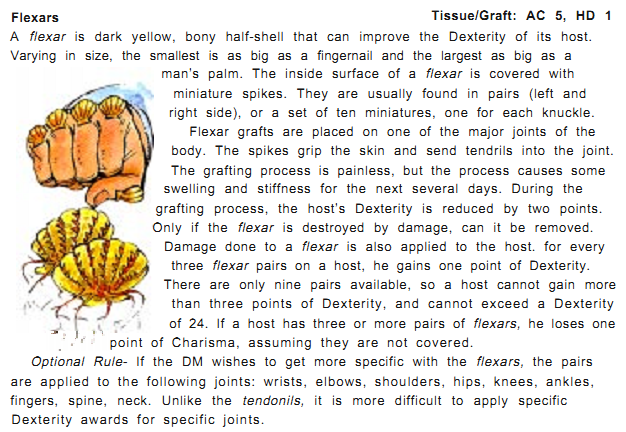
The first of several stat-boosting life-shaped items. The Flexars are also another one of those "can never be removed" grafts. So get used to your seashell knuckles.
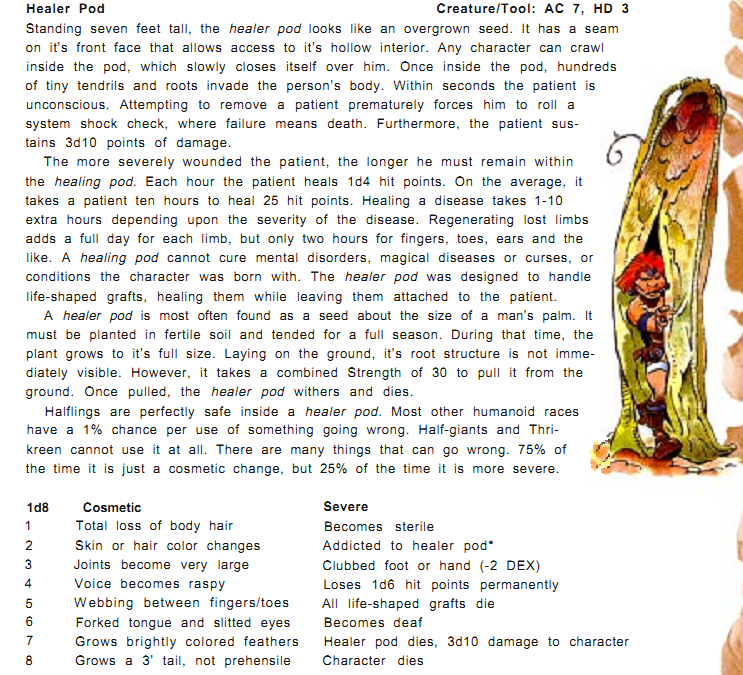
The healing pod is basically a life-shaped Bacta Tank...except you'll probably die if you have to get out early.
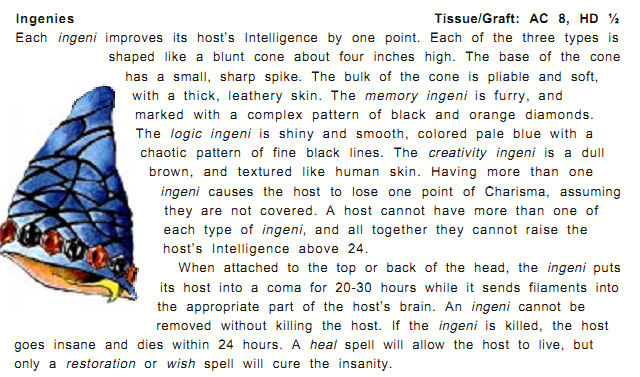
Another stat-booster. This time for intelligence. Honestly I can't really imagine what Ingenies look like when grafted in place...I guess like soft, weird horns sticking out of your hair?
Oh, and for even more fun, if any of your ingenies die you go insane and die within 24 hours! Considering that they have only 1/2 a HD that means that if you get caught in an AOE (or if your opponent just decides to aim for the the obvious meat-horns on your head) you die. Oh, and life-shaped tissues have a .1% chance per week of catching a fatal disease and even in the best circumstances they live only 1-2 years. Hope the +1 intelligence was worth it.

Wrist vaginas are all the rage in rhul-thaun fashion these days.
The klacker is another weird, pseudo-magic bit of life-shaping. At least presumably other-planar beings were around back in the Blue Age...presumably at least. The details of things like elemental magic in the Blue Age are quite vague.
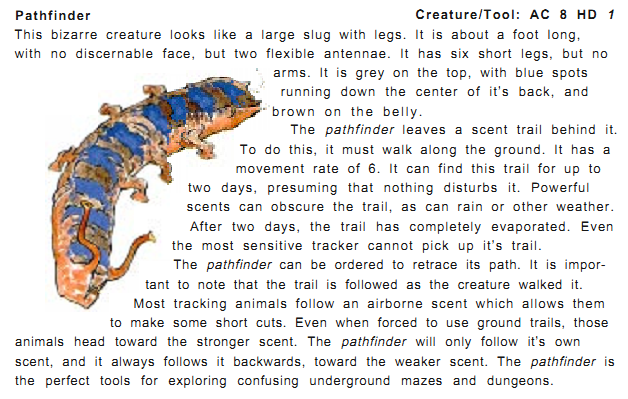
The most hated life-shaped items by fans of 4th edition.
The Pathfinder is one of those life-shaped items that's theoretically useful but there's tons of much more practical ways to do things (say by drawing or carving markers). For instance, the fact that the pathfinder can only follow its scent trail on the ground means that if you have to pick it up and carry it then it'll lose that trail and become useless. And considering that you have to allow it to walk along all the way through whatever maze or trail you're trying to mark and all the way back...no mention is given as to how fast the Pathfinder can travel. Considering its basically a foot-long caterpillar I can't imagine its very quick. (EDIT: Alternatively I could actually read the entry more carefully before I post and realize that I don't always know what I'm talking about. I still submit it's impractical though and that the summoner is totally broken).
Anyway, that'll be all for now. I'll finish the rest of the life-shaped later.
More Life Shaped Items
Original SA post
Psionic Artifacts of Athas part 6:
More Life Shaped Items
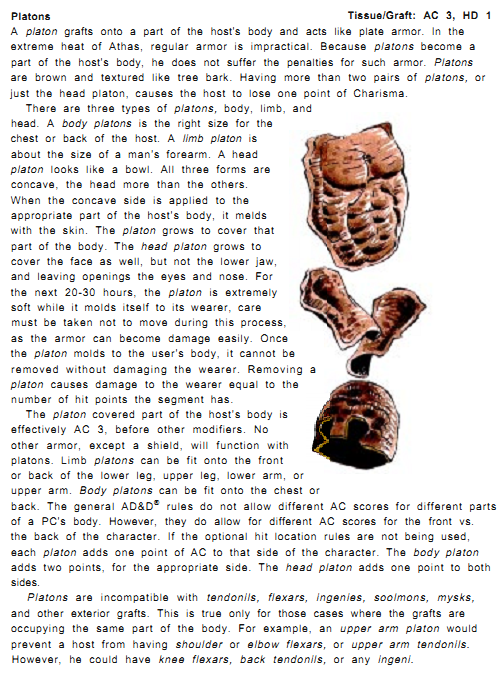
Platons are basically a symbiotically grafted suit of plate-mail that is worse than most of the rhul-thauns existing life-shaped armor (providing AC 3 vs Half-Shell's AC 2 or Full Shell's AC 0). The upside is that presumably it has no encumbrance (at least none is mentioned) and you could probably sleep in it? Of course, the downside is that you have to sleep in it, because unlike other life-shaped armors this one cannot be removed without actually cutting it off (each segment inflicting its hit points in damage to the wearer). Again, no consideration is given to the fact that these items live 1-2 years tops.
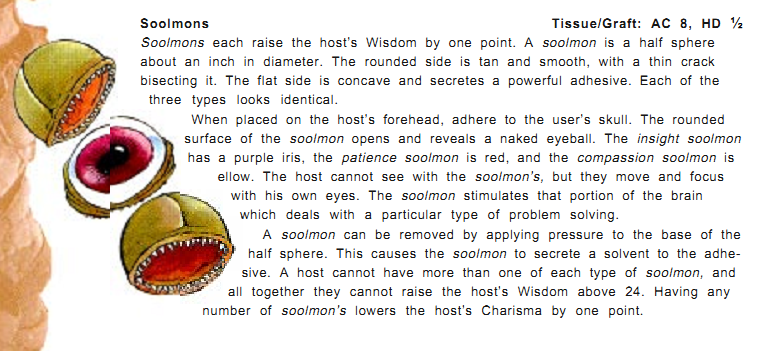
The wisdom-boosting implant. Notably unlike the Ingenie the soolmons are removable and they don't kill you if they're damaged. Wise indeed.
Also, the illustration of closed Soolmons looks kind of like angry little butts.
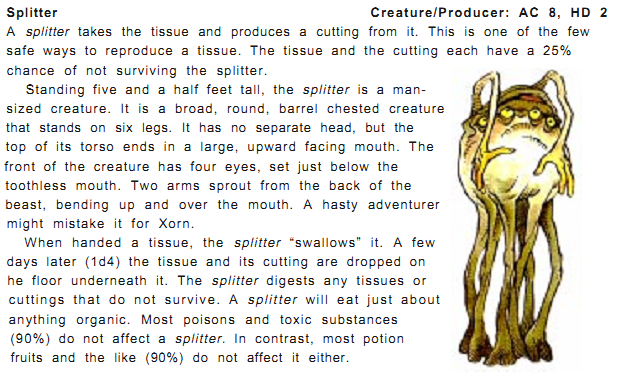
This goofy looking bastard could potentially be very useful for producing tissues, especially since they have such a short life-span. Of course, a lot of tissues wouldn't even fit inside it and the 25% chance of death is quite the gamble if you're short on supplies. So you might end up with absolutely nothing...or enough tissues to fit out the entire party. Who knows.
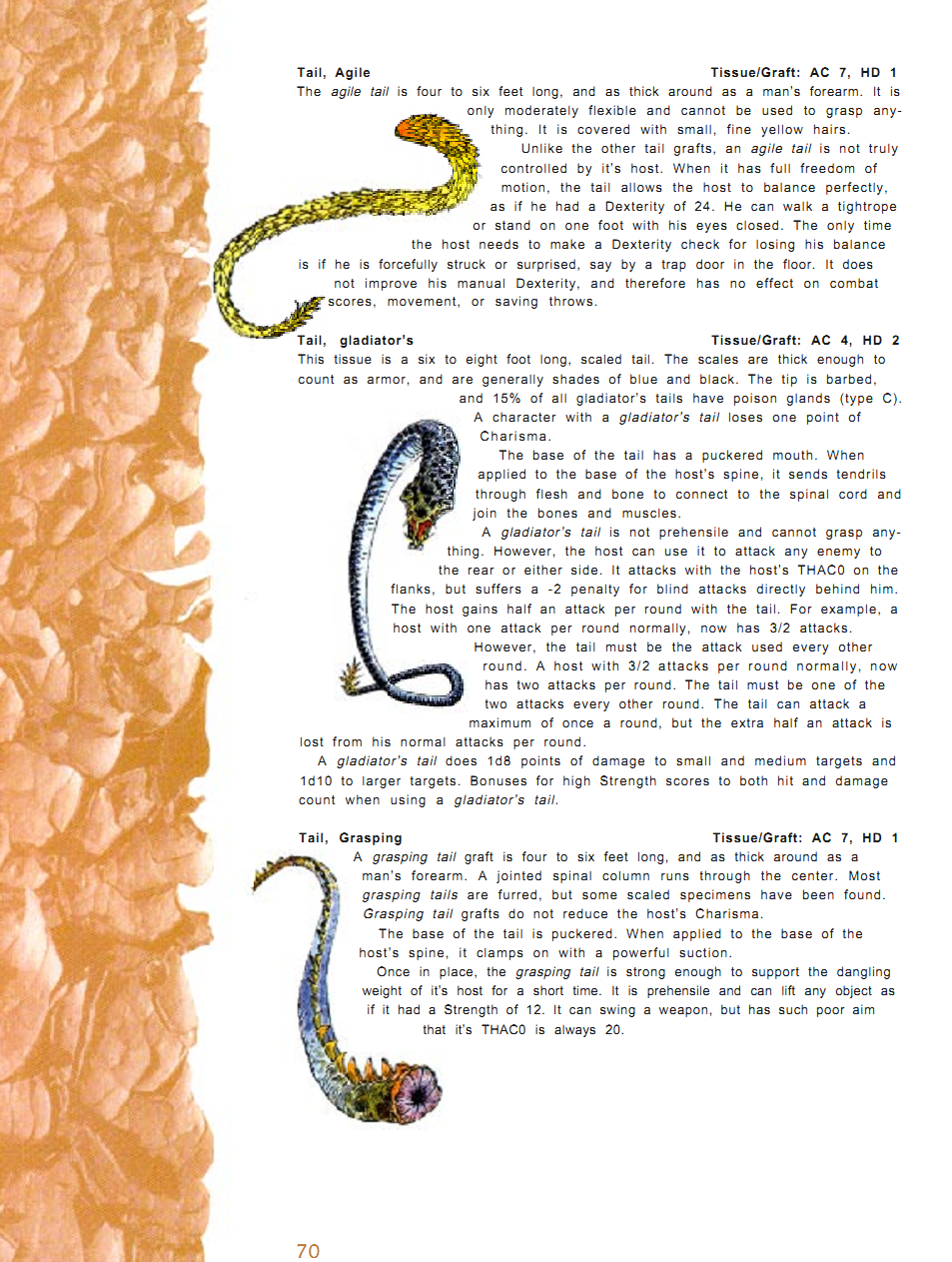
Tails! Most are actually pretty useful (the gladiator tail in particular is probably one of the best life-shaped weapons out there)...although the grasping tail does kind of look like a halfling fleshlight.

Another flesh-light tail. This one is purely cosmetic, for those halflings who want to express their fursonas.
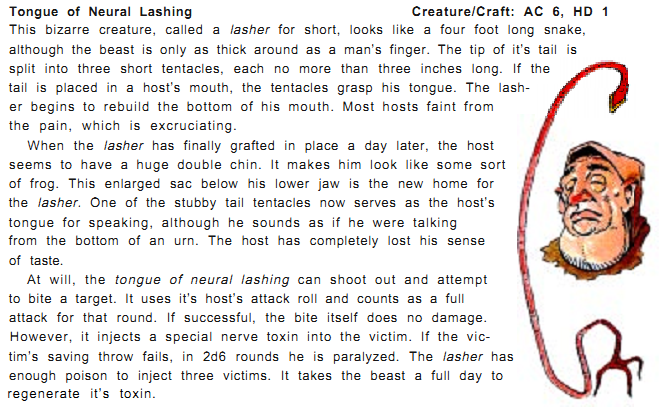
Like a lot of the items in this book this is one of those "spoil your life in exchange for mild benefits" trade-offs. Now the paralytic toxin isn't bad, it's quite a useful trick to have...but in exchange you never get to taste food again and you look like you've got giant guinea pig testicles on your chin.
I mean, who would make that trade-off normally? Theoretically an assassin or similar fanatical soldier might make that sacrifice for a powerful hidden weapon...except its not even hidden because it gives you giant frog mouth.
And of course all of these problems could have been solved just by implanting the graft somewhere else on the body. But nope, got to be a tongue for some reason...except of course there's the Venom Whip, a graft that is exactly this thing except not stuck inside your face.
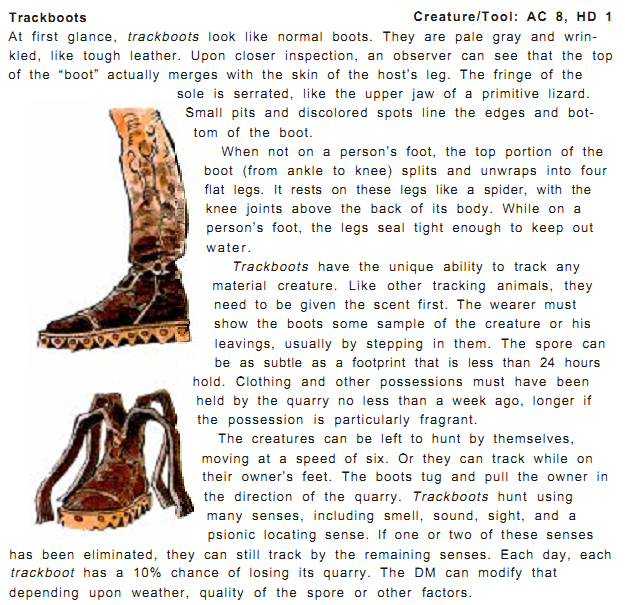
I find Trackboots oddly adorable. And hey, a pair of boots you can take off without literally cutting the soles of your feet off!
And if you step in dogshit you can hunt down the bastard who didn't clean up after their dog.
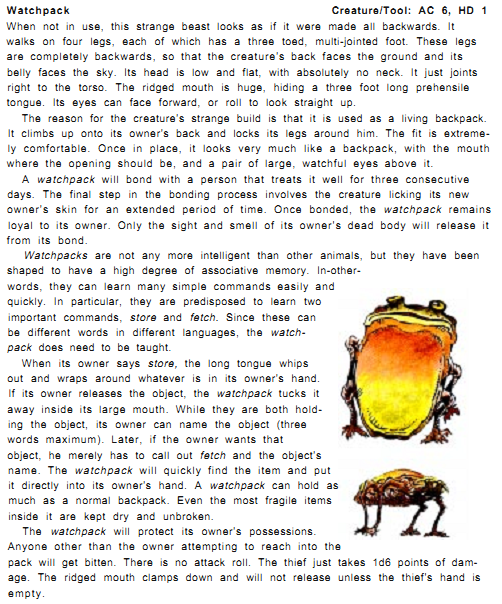
I have no idea why an organic backpack requires six large paragraphs of explanation.
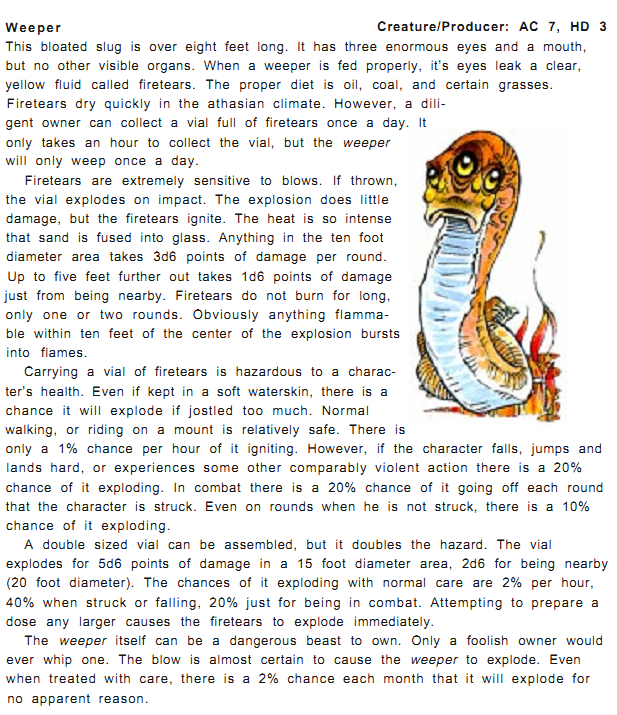
The Weeper is another lengthy one, but at least its a bit more interesting...if very unsafe.
Basically it produces organic hybrid of nitroglycerine and thermite, and that's just as unsafe and unstable as it sounds. If you're carrying some there is a 1% chance per hour of an explosion, which will naturally set off any other firetears. In combat that chance rises to 20% per round if you're struck, 10% if you aren't. Oh and the weeper itself explodes on a roll of 2% or lower each month.
That seems...impractical.
That's it for the main chapter on life-shaped objects...but for some reason this is not the only chapter detailing them. The book has a 5-page appendix of life-shaped creatures and tools in the back. There's no clear reason why these are put somewhere else. They don't have as many illustrations but not every life-shaped object in this chapter has an illustration either. Likewise they're almost all reprints from the Jagged Cliffs book...but so are many of the items in this chapter.
The appendix is terribly laid out, there's no organization so you've got a mixture of life-shaped creatures like the climbdog or the breeze sprite alongside more regular items. It also includes several life shaped weapons such as the hurling titan and the armspike...but no damage or other weapon stats. It's also clearly copy-pasted entries from Wind Riders since they often refer to lifeshaped items that aren't included in this book. For instance, Mimic skin is in the appendix and it states that it is "applied much like sheath armor"...which is not included in the book (in fact, no armor was included for some reason).
I love you Dark Sun, but TSR did not treat you right.
Anyway, next we'll get into "life-shaped artifacts". That's not ancient rhulhisti artifacts that can't be created anymore, but actual artifacts (with supernatural powers) that are also life-shaped beings...somehow.
Locally Grown Organic Artifacts
Original SA post
Psionic Artifacts of Athas part 7:
Locally Grown Organic Artifacts
So, now we're back into actual Artifacts...sort of. You see these are life-shaped artifacts. And they kind of highlight one of the major issues with life-shaping in Dark Sun: the writers just can't decide if its magical or not. On the one hand almost every life-shaped item presented (including ancient rhulhisti ones) falls under the category of "soft sci-fi biotech"...the sort of stuff that could be theoretically created through guided evolution and/or genetic manipulation.
Then you get the weird stuff...the Pristine Tower is probably the "prime" example, especially since it has such a large role in the setting's history. How does bio-manipulation give you a device to drain and harness energy directly from the sun? Who knows? That more or less sums up the rest of these artifacts. A few kind of make sense...but part of the problem is we have very little information about what was going on in the Blue Age. We know they didn't have wizardry or psionics...the heavy implication is that clerical magic existed but was largely considered a curiosity (a little weird since a high level cleric has powers that put life-shaping to shame). Druidism is simply not mentioned. Well...did they have things like demons? Undead? supernatural creatures? No clue.
The opening for the chapter claims that these artifacts are the product of the life-shapers experimenting with the creation of intelligent or free-willed creations...except that the majority of these artifacts are not intelligent. Some have curses or "built in" agendas that they force on their bearer...but they are largely not sentient beings. Even if they were, that doesn't explain how being intelligent gives them magic powers.
So with that resounding
 we start with the life-shaped artifacts.
we start with the life-shaped artifacts.
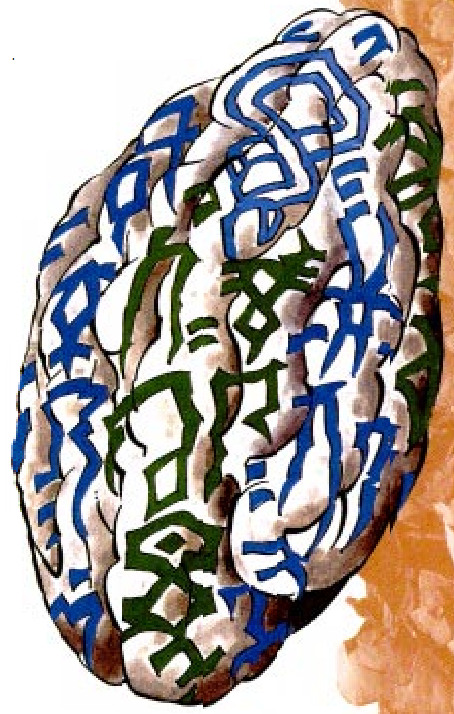
The Centennial Brain
Apparently called "centennial" because the brain is a melding of 101 of the greatest Rhulhisti minds (literally). The creation of a mad life-shaper who murdered them, took their brains and squashed them together. Basically its an artifact version of the Overmind from Windriders of the Jagged Cliffs and does exactly what you'd expect of a giant brain: thinks a lot. The whole thing is 8 feet in diameter and covered in glowing runes (wait...what? They really are forgetting that life-shaping isn't magic aren't they?). The brain has developed psionic powers over the millennia but it is utterly helpless without a "host" to channel its powers through.
The brain has immeasurable intelligence. It can communicate telepathically with anyone touching it and knows most anything or knows how to find out anything it doesn't know. It refuses to deal with philosophical nonsense however like the meaning of life or the nature of morality. It mostly doesn't give a shit about people.
The brain knows every psionic power there is, but can't use them itself (which is weird). Instead someone must touch the brain in order to serve as a channel for the power, using their own power points, level and ability scores.
Every time you use the brain the GM rolls 1d10 in secret, once these rolls add up to 100 or more then the brain absorbs your mind, leaving you a mindless slave. The brain then uses this slave to channel its powers until their body gives out from the strain (usually a year or two).
Oh, and several life-shaped artifacts don't have suggested means of destruction, they simply have their own AC and HD and presumably can simply be killed by chopping them into pieces. Given the centennial brain is a big, unmoving pile of meat I'm shocked it hasn't just been eaten by some random predator. It has AC 5 and 16 HD.
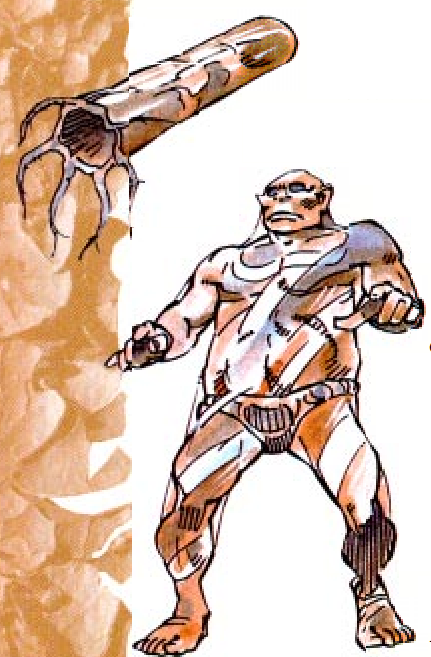
The Corundum Wormskin
Why do so many life-shaped items look like horrible fleshlights?
The corundum wormskin is an example of a case where the writers created something that seems like it could be a powerful life-shaped objects...but forgot that the Blue Age was called the Blue Age because the world was covered in water. The premise of the wormskin is that the halflings created sink worms (Athas's sandworm ripoff) in order to excavate and mine for gemstones...except we know from Windriders of the Jagged Cliffs that they don't mine or indeed care about mineral wealth at all. Sinkworms are also not aquatic.
Anyway, the corundum sinkworm supposedly was the accidental product of this breeding program which turned on its creators. It was killed but this small piece was indestructible and retains the super-sink-worm's abilities. Basically this artifact turns you into a watered-down King Leto from Dune.
The corundum wormskin is a small "sheath" of corundum (the mineral that rubies and sapphires are made from) which is conveniently just long enough to slip over a human's finger. It fuses with the skin and becomes irremovable and begins to grow to cover the entire body. Every month AC improves by one until it hits -2, along with a slower progressing charisma and dexterity penalty. After 12 months you lose your human sentience and literally become a sink-worm with a gemstone skin. At that point you must become an NPC for another two years as you grow into a full-sized worm.
You will then allow the largest male sinkworm to mate with you, lay an egg and burrow into the earth, never to be seen again.
The egg then hatches, revealing...you! You have your old class, level and memories back and are fully playable again. Your AC, charisma and dex have all returned to normal although you have a gemstone finger. You also have the powers of a Worm Lord now. This gives you the equivalent of Tremorsense 120' on sand so long as you don't wear shoes and lets you burrow at your movement speed through sand or silt and you don't suffocate underground. You can also phase through 90' of rock once per day and by performing a 10-round-long dance you can summon a sinkworm once per week, serving you for 24 hours so long as it remains in your presence. Plus a bunch of random abilities: one each from Detection, Divination, Elemental earth and minor spell-like powers.
Oh, and there's a 1% chance whenever you summon a sinkworm that it'll be the worm you mated with (exes are always a pain) who is immune to your control and will attack you.
So, put on a finger sheath, spend two years as an NPC and in return you get a modest selection of supernatural powers...the equivalent of maybe two decent mid-level magic items. That's a rip-off. Really its an item that is only interesting for an NPC and even then its hardly powerful enough to make that big a difference outside of specific circumstances.
Oh, and the entry forgot to include any rules for what happens to the wormskin itself. A straight reading seems to indicate it is a one-use item as your original crystal sinkworm body disappears forever into the center of the earth and your new Worm Lord body has a solid-crystal finger but no indication that this somehow turns back into the hollow crystal tube if the Worm Lord dies. But there's indication of there being multiple corundum sinkworms, so presumably the life-cycle must continue. Nor are any guidelines provided on what would happen if the crystal sinkworm was killed before it lays an egg.
The wormskin has AC of -4 and 1-20 HD depending on its life-stage.
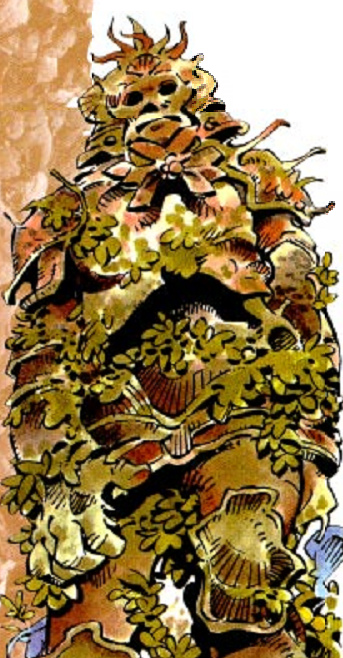
I am Groot!
The Green Rhul
Despite my general critique of this book I quite like the Green Rhul. It's cool (who doesn't want to walk around in leafy power armor?) and it actually makes a fair amount of sense as a piece of life-shaped technology.
The Green Rhul is a nine foot tall plant that you can wear as basically organic power-armor. This artifact is intelligent (18) and speaks the language of the ancient rhulhisti. It usually permits people to enter it (there's a seam in the back) unless it is already bearing a rider, at which point tendrils punch into your skin and bond with your nervous system. This allows the Rhul to communicate telepathically with its rider (ignoring language barriers) and the rider can share the Rhul's senses to see and hear what it does. If the Green Rhul is willing it can also follow orders or requests independently without being ridden....or not because the very next paragraph states that the rider provides the neural hook-ups it needs to operate its muscles and it cannot move without an occupant.
Druids apparently have legends about the green rhul, claiming that they created it, a claim that is clearly false. They do have a legend that a druid did find the Rhul and used it to wage war against a city-state, however once the curse kicked in the druid marched into the silt-sea to die (why the rhul allowed this is unclear)...which is pretty ridiculous when you see how mild the curse is.
While inside the Rhul the wearer has AC 0 and all damage goes to the Rhul and not the occupant (the Rhul has 8 HD, making this a fairly bad deal for most mid-to-high level characters) Psionics and magic could potentially bypass this protection but must be specifically targeted at the occupant. The Rhul has a strength of 24, a speed of 9. All other Attributes are as the character riding...although it apparently has a full suite of attributes itself (Dx-13, Con-24, Int-19, Wis-11, Chr-3). It's already contradicted itself with the intelligence (and the difference between 18 and 19 is pretty big in 2e) and its unclear how it can have its own Dex score if it can't move without a rider and with a rider it uses the rider's dex.
The rhul is immune to poison, gasses, disease, and "any environmental effects" (what that means is unclear). The host is likewise protected and doesn't need to breath, eat or drink within the rhul.
The rhul also shares its combat experience with the rider: all opponents must declare their actions for the round first then the rider can take actions based on that info. This is only presented with the assumption that a PC is riding the rhul and that the opponents are NPCs...its pretty awkward for players to have to declare their actions in advance considering they should be able to act based on previous character's actions.
The rhul can also "plant" itself to feed itself. An hour of sunshine feeds it and its rider for a day, and it can't heal if it is denied sunshine.
It has also developed psionic powers, it has 100 PSP,s and one random science and three random devotions. The rider can use these powers at will, drawing from the rhul's PSP supply.
The Rhul's curse is that it transforms its occupant into a halfling (this is what freaked the druid out so badly that he walked the rhul into the silt sea). And it will gradually take control of its occupant to allow it to live as a free being (since it needs an occupant to allow it to move). The text provides no guidelines for this, instead using the term "artifact possession" and "artifact transformation", as though we are supposed to know what they mean. These are terms from the book of artifacts where they have very specific mechanics...which are not reprinted in the Psionic Artifacts of Athas or used in any other artifact entry in this book (even ones that possess and/or transform the user).
Unlike the first two life-shaped artifacts the Rhul has the standard artifact indestructibility. Reducing it to 0 HP just renders it inactive (healing 1 HP per day). Even turning it to ash will cause one of the pieces to eventually sprout into a new Rhul. It could be permanently destroyed by the touch of the descendant of the first true druid (why?), an ancient halfling (meaning one from the blue age itself) must sacrifice itself by riding the Rhul, or it can be burned by the breath of the Dragon (who is already dead...).
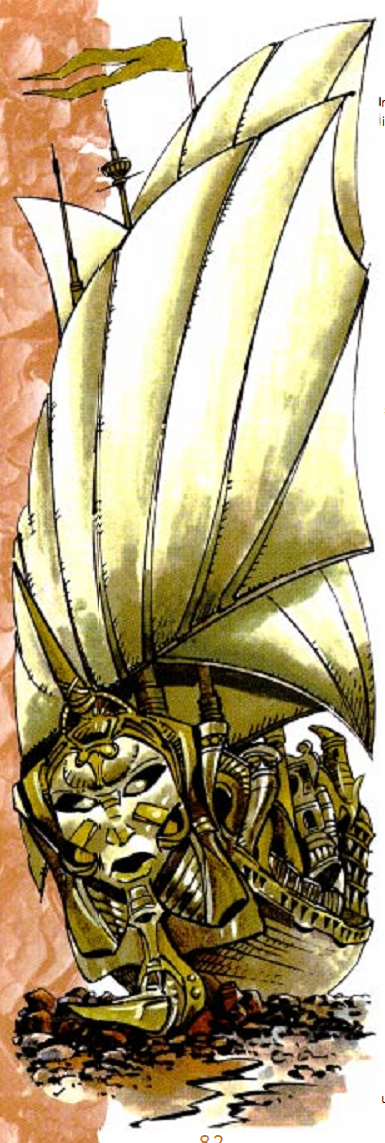
The Jade Marquess
The Jade Marquess is a wonderful exercise in making no fucking sense. In fact, if I had to guess I'd say it's probably two artifacts awkwardly smashed together...or a more standard artifact given a "makeover" as a life-shaped object.
The Marquess is a ship that was supposedly designed in the Blue Age, back when the world was covered in water, explicitly for the purpose of sailing on land. In fact it can't sail in water at all!! It also very distinctly looks like a normal ship crafted of carved wood, not a piece of life-shaped technology, which you may recall looks more like this:
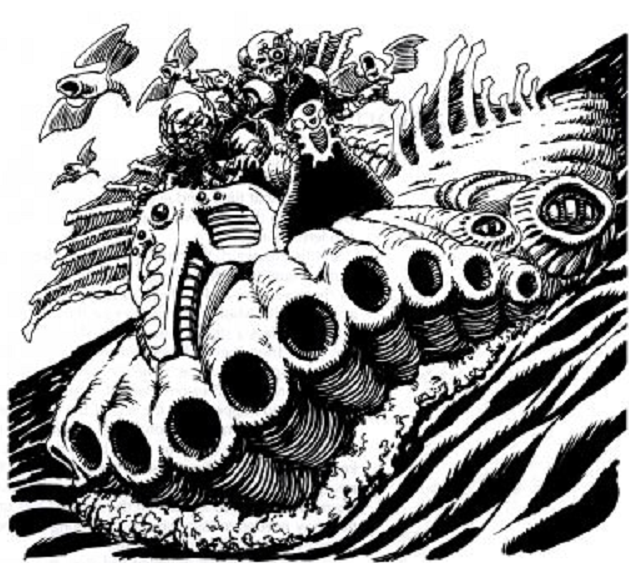
Real ships have curves
The history makes this even weirder: we get a single short paragraph detailing the fact that it was made in the blue age for unknown reasons. Then we get a much longer story about how the Marquess appears in elven legends where it was a gift to the elves by earth elementals (a backstory that makes a lot more sense) and how the elves became awesome land-pirates.
The main function of the Marquess is that it can sail on land at a speed of 12 and on silt at a speed of 18. It can't climb inclines greater than 30 degrees or sail over large rock outcroppings. It doesn't phase through earth, it literally sails on top of the ground, carving a big trench behind her. How this works is unclear. Whoever is at the helm can control the Marquess and command all of her functions.
One of the weirder aspects of the Marquess is that her size varies depending on how much food she's eaten and how many HP she has. The Marquess has 30 HD when fully fed and is 120 feet long, with three masts and four deck levels. However, when shrunk her features are reduced proportionally and at her smallest (3 HD) she is only a canoe. She can shrink if not fed properly (which is annoying but not crippling) but the big problem is that damage shrinks her. Every 5 points of damage causes her to lose a foot in length...which means even modest damage could suddenly cause you to not have enough room for your crew or cargo (something that is not addressed at all). Even worse is that the Jade Marquess's weaponry is available only at certain sizes, meaning damage could easily disable your weapons.
Oh, and another weird thing. The Jade Marquess' HD are always 1/4th her size (so 30 HD when at her full 120 foot length, 3 when a 12 foot canoe). So...that means that damage reduces her HD along with her size...which means that the more damage she takes the less hit points she has (which is less of a tautology than it sounds). Again, the effects of this are not actually addressed. Indeed, no rules are provided for what happens when the Marquess is brought to 0 Hp and how fast it heals.
Despite this the artifact entry grandiosely claims "No storm, spell or creature can sink the Jade Marquess" which I guess is true since it sails on land.
The Marquess is immune to spells that would change her "shape or nature" (what is her nature?) and she is immune to mind control (of course at no point is there any indication that the Marquess has a personality, intelligence or desires beyond simple hunger). Plus she is immune to all psionics.
The Marquess has built in weaponry depending on her size:
*40 feet+: a weird thing on the front that has a random offensive power
*60 feet +: a second, identical thing that fires from the rear.
*80 feet +: a side-mounted weapon with another random power from the same table.
*100 feet +: a second weapon on the opposite side with an identical power.
Keep in mind that due to the nature of these tables each weapon can probably only fire once per day, making for an underwhelming power.
The curse of the Jade Marquess is two-fold. First she has to devour living beings or she'll shrink. Growing requires she consume the appropriate number of HD worth of living creatures per week and she'll shrink if she consumes less than half her HD in creatures. It's not clear but presumably anything between half and full is sufficient for her to simply maintain her current size? This is a fairly mild requirement but it does bring up one big problem with the Marquess: its not very impressive. She moves slowly and requires regular feeding...you might as well just travel by caravan. She's not exceptionally tough or durable and while she comes with some weapons they're very limited use and not that impressive. Oh, and if she's currently shrinking she has a 25% chance to chase down and try and eat living creatures she comes across with a bite that inflicts 1d6 damage per 20 feet...something that would actually be a decent weapon at full size but there's no indication that the captain can order her to try and bite or devour enemies.
The second part of the curse is that anyone who sails her becomes tied to the ship and cannot leave for more than a day without succumbing to a geas to return. When they die they rise as undead and follow in search of the marquess (as a result it has twice as many encounters with undead as normal...whatever that means.
Suggested means of destruction are having the undead spirit of her first captain sail her into water where she will dissolve, an elf who is the eldest daughter of an eldest daughter unto 11 generations must willingly sacrifice themselves by being eaten...or she must be tricked into eating a moonbeam...WTF?
Anyway, that's all for now. Next we'll be finishing up the living artifacts.
Rhul-Tal Wrapup
Original SA post
Psionic Artifacts of Athas part 7:
Rhul-Tal Wrapup
So, the second half of the living artifacts where we start ripping off Vecna, and body parts. Of course, its sort of understandable for bio-artifacts so I don't hold it against them.

The Ma-Kat Mannequin
You know, I've noticed a tendency in this book to confuse the Rhul-Thaun's lifeshaping with more generic "nature" based effects like druids. One of the ways this manifests is in the form of things like wood or plant themes (seen before with the green rhul or the last tree). Forgetting of course that the halflings of the Blue Age lived on a world covered in water and thus weren't likely to be very interested in things like trees. Say what you like about it but Windriders of the Jagged Cliffs at least had a consistent theme and style to their life-shaped creations that is completely lacking in these life-shaped artifacts. That said, this artifact at least was clearly built with life-shaped items in mind, not just a half-assed normal artifact that's claiming to be life-shaped like the Jade Marquess.
So, here we have the Ma-Kat mannequin, full-size wooden figurine of a halfling that is so lifelike it actually breathes, has a heartbeat and is warm to the touch. The mannequin has deeply carved "tattoos" that are filled with blue and green pigments and its completely indestructible. No weapons will harm it and neither magic nor psionics have any effect on it. The mannequin itself does nothing at all, but searching it (requiring a find secret doors roll) reveals a hatch in the chest which opens to reveal the mannequin's wooden heart, beating in its chest.
Now, in order to get any benefit at all from the mannequin you have to go full on "Head of Vecna"...cutting out your own heart and swapping it with the mannequins. Or I guess more accurately having someone else do it because naturally you die in the process. Hope you have someone you really trust. Once the wooden heart is placed in your chest cavity it will start to beat and your gaping wound will heal over and return you to life, while your heart beats inside the mannequin's chest. Sadly, the actual benefits of the mannequin are quite lame, especially given the curse.
You see, the mannequin serves as a "stand-in" for life-shaped grafts. Life-shaped grafts will "attach" themselves to the mannequin but will function for the owner. So for instance, if attach a set of platons to the mannequin you'll get the benefits of improved AC despite the fact that you still look normal. Attach an armblade and you'll have an invisible blade jutting out of your arm (useful for surprise attacks...not so much for 99% of the rest of your life where having an invisible sword that you can't remove jutting from your arm is a huge hassle).
The exact details on how this works are very vague, especially given the detailed requirements of several grafts. For instance, it states that an armblade graft will produce an invisible "edge" that can be used to cut foes and so on but the graft itself or the flat of the blade cannot be felt. But what about grafts that must replace a body part such as an eyestalk or that weird frog tongue? Do grafts still drain nutrients from the host? What about things like illness. If an inginie grafted to the head of the mannequin dies does the host still go insane and die? It makes a point of mentioning that no one has any idea how this works or even how the mannequin was created, it's named for a famous owner of the mannequin but no one has any idea how it is capable of doing what it does.
In addition, you get three random powers: Fate and Fortune, Immunity and personal enhancement. These are fairly lame (the example powers given are never being lost, immunity to energy drain and +1 to saves).
Now, the actual benefits of the mannequin are only moderate at best (and rely on having a lot of life-shaped grafts already) but the curse is the real clincher. You see, the mannequin's heart is only on loan and it will take it back. There is a 1%, cumulative chance per month that the mannequin will rip own the wooden heart and vanish. Nothing can stop this at all. For such relatively minor benefits that is a huge curse, absolute death in a matter of years (someone better at probability than me could probably calculate when an increasing percentage is becomes near 100%, I can't imagine you'd last more than two years without a lot of luck). The mannequin will vanish and then reappear at some later point (with no life-shaped grafts) ready to go again.
suggested means of destruction: a kiss from the daughter of a barren woman, burn it in the heart of the cerulean storm, throw its heart into the sun, fill in the carved tattoos with the blood of a rhulhisti (an ancient halfling, not merely a jagged cliffs halfling).
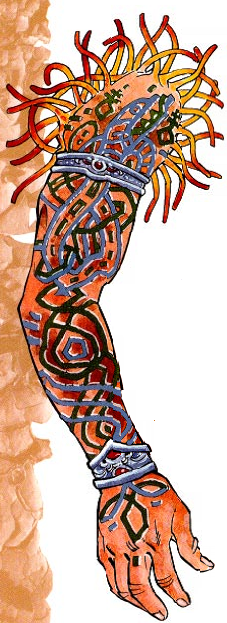
The Arm of Radu
Despite the visual similarities and being another "vecna-style" artifact the Arm of Radu has no relationship with the Ma-Kat Mannequin.
The Arm of Radu used to be the arm of a guy called Radu. Shocking, I know. This entry actually remembers that all Rhul-Tal are supposed to be intelligent, assigning the arm an intelligence of 15. By the way, for those keeping score there are 3 actually intelligent life-shaped artifacts (the arm of radu, the green rhul and the centennial brain) a set of artifacts that contain intelligent beings (the spirit wombs, yet to come), two artifacts that aren't intelligent but will act independently in some situations (the ma-ket mannequin and the jade marquess) and two that are basically just things (the wormskin and the tongue of glib the mad).
The Arm is also not actually life-shaped (which is notable because one constant theme of life-shaping is that while the halflings may create symbiotes or servants they never alter their own being). It belonged to an Important Halfling named Radu who was a great construction genius and general smart guy but when he died he (for no particular reason) became an undead and his arm fell off, becoming the Arm of Radu.
The book seems to indicate there are lots of legends about not simply the arm but Radu himself, which seems impossible considering that he lived during the Blue Age and the Rhul-thaun are so bad at record-keeping they can't even remember the name of their last High Lord and they practically worship that guy.
Anyway, if you stick the arm onto an empty shoulder socket it'll seal itself in place with its tentacles and become your new arm. If you stick it on a shoulder with a living arm it'll still lock-in but both arms will be useless until your original arm falls off 1d10+10 days later. The Arm of Radu cannot be removed without killing the host. The fact that the arm belongs to a halfling is never addressed in regards to other characters using it.
The arm will speak to characters in their dreams, appearing as a halfling in white robes and gives them dreams of building great wonders (it can only communicate while the host is asleep).
Despite being so obsessed with building the arm does not actually grant any powers related to building! It is very strong (strength 20) and has sharp nails that function as a powerful weapon (2d6 damage). On a roll of 20 the arm grabs the neck of whoever you're attacking and starts to choke them. If you want to let someone you're choking go you've got to make a saving throw to overcome the arm.
The only other powers of the arm are just a collection of random powers from different tables: Abjurations, Cataclysms, Combat, Elemental Earth, Immunity, Major spell-like power, and offensive powers. Well, we're told they're random because the entry then gives a "default" power for each table (the worst of both worlds) and we're then told that the earthquake power (the cataclysm default) activates itself at random whenever the GM wishes. It's also mentioned in the item's entry as being part of the curse. So presumably not random at all.
The main curse of the artifact is that it'll get pissy if you don't build stuff. If you aren't engaged in at least one hour of construction per day and using the arms powers to do so then it will scratch you. This makes the random power selection even stupider, if you roll randomly it is very possible you end up with no powers that could be even theoretically used for construction. Even the default powers aren't helpful there's Move Earth (only usable once per week, so good luck on the other 6 days) and Telekinesis. The TK at least can be used easily, but it won't really be helpful.
The scratches leave deep scars but do no damage. The scars are located on random body parts and every 3 scratches on the face drops charisma by one (up to 3 points). If the host suffers 1001 scratches the arm will fall off.
Otherwise the suggested means of destruction are for the shade of Radu to break the arm over its knee or for it to be hurled into the Dark (there is not actually a dimension called "The Dark", they're probably referring to "The Black", Atha's shadowplane). Or it can be dipped into elemental air, fire, water and earth within 3 days.
Despite this, it has only AC 2 and 5 HD. no indication is given as to what happens if the arm is damaged or reduced to 0 HP.
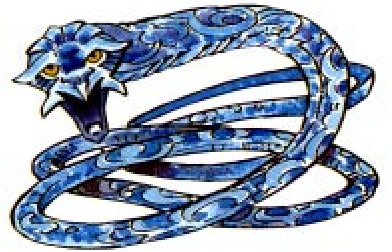
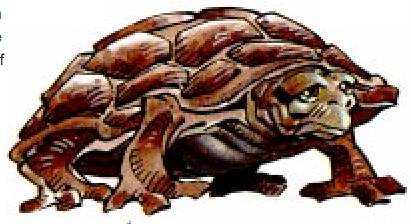
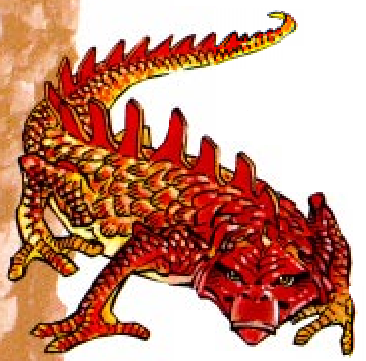
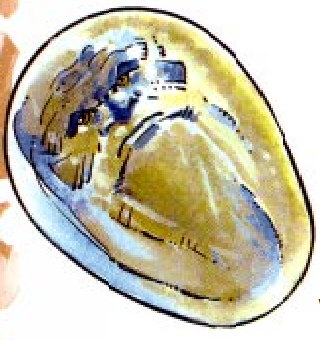
The Spirit Wombs
And the prize for "stupidest-looking thing in this book" goes to the water womb!
I've actually got a sneaking suspicion that the last illustration (which claims to be the water womb) was mixed up with the first one (which is meant to be the air womb) since the "water" womb has the light blue coloration you typically associate with sky and at least is somewhat streamlined looking while the air spirit has the deeper blue you'd associate with water and the serpentine shape doesn't make much sense for an air-based creature. The actual text descriptions to match however (except the part where it claims they all have "human-like faces").
Apparently each of these was actually created as a life-shaped "trap" for a Spirit of the Land (the beings that druids get power from) by an ancient, dickish life-shaper. They're apparently the reason that Spirits Of The Land are so reluctant to interact with anyone other than a Druid. As a result of course, Druids find the wombs to be an abomination.
They're very big (air spirit is 30 feet long, earth womb is 12 feet in diameter, fire womb is 16 feet long and the water womb is 10 feet in diameter) but are given absolutely no combat stats, despite nothing indicating that they would be incapable of combat. They're capable of speech and feeling pain but are invulnerable. Since they apparently have the sentience of the spirits it's not actually clear how these are artifacts and not simply powerful creatures. In fact, there's no indication given as to how they would be controlled, beyond presumably torture. They're all very slow (movement of 3) unless they're traveling through their element.
Air Womb
The air womb flies at a speed of 24 (dropping to 12 if it flies through impure air such as rain or dust). It has the powers of an Air Spirit (gating in air, creating an hour long hurricane, and casting whispering wind) as well as four random Elemental Air powers.
Earth Womb
Can phase through earth and rock at a speed of 24 but drops to 12 through mud, silt and lava. Powers of the earth spirit are gating in earth, creating a big, collapsing stone wall and communicate by transmitting vibrations through the earth. Plus four random Elemental Earth powers.
Fire Womb
You may be starting to notice a pattern. The fire womb can travel through fire at a speed of 24 but can move at 12 in "hot air" (over 120 degrees) or smoke. It also keeps the rider from being harmed by heat (something absent from the earth spirit...can the rider breath while phasing underground?) It has the ability to cast wall of fire, create a hot wind of volcanic gasses (acts like a stinking cloud but gives no area) and can use fires to communicate. Plus four random elemental fire powers.
Water Womb
The water womb swims at 24, down to 12 in mud or rain. Needless to say its not much use in that department although it does allow you to breath underwater. It can gate in water, cause a pool to try and grab someone and drown them and can communicate through water. Plus the same four random powers.
Each womb also has a more or less identical curse. After a month the owner will fall in love with a piece of landscape that matches the appropriate elemental theme and is compelled to visit the place at least one day out of every month and risk their life to protect it.
Owning multiple wombs gives extra benefits in that part of your body turns elemental depending on which two wombs you own (they won't tolerate opposing elements, only adjacent). Part of the owner's body turns elemental, granting airy legs (fly at a speed of 3), stone fists (d8 damage and can stone shape 1/day), fire hair (affect normal fires 3/day), ice face (what? apparently lets you use telekensis to control water 3/day and heal 1d8 dehydration damage with a kiss).
However, multiple wombs gives extra curses too: -4 to saves vs elements that oppose the element you're partially composed of and attacks with those elements get +4 to attack rolls. The owner also suffers a random cataclysm. Presumably you also have to visit and protect two different plots of land as well, but this is never addressed.
This does bring up a big issue that is completely unaddressed: Who is the owner of the wombs? These are massive, invulnerable, intelligent creatures...how does one become the official "owner" of a womb? Does anyone riding a womb count as an owner? anyone the womb uses its powers for? Does the womb have to give permission or consent? Can there be multiple owners? How does one stop owning a womb?
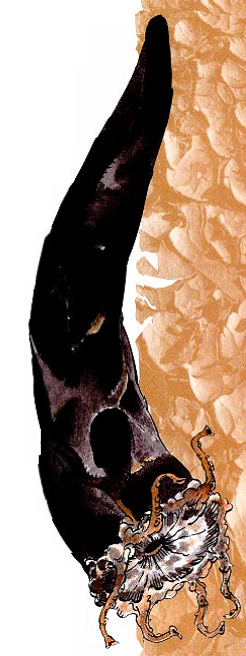
The Tongue of Glib The Mad
This is the last halfling fleshlight, I swear.
The Tongue of Glib The Mad is more or less the same as the Arm of Radu. It's not actually a life-shaped item at all, it's just the tongue of some ancient halfling called Glib who was very persuasive and after he died apparently the life-shapers decided his tongue must be the reason he was so convincing so they had it preserved...a sort of superstition that is entirely at odds with the Blue Age culture we've been presented with so far. Apparently the tongue somehow grew a mouth and little tentacles and is totally magical (or whatever the excuse for life-shaped artifact powers are).
Oh, and as the name implies, Glib was kind of crazy because he eventually started believing his own lies. But the artifact is totally safe, I promise.
Of course, this requires that you replace your tongue with it, if you just stick the mouth end on your tongue it'll latch on and eat until it hits your jaw and fuses to your mouth.
This is by far the most powerful life-shaped artifact, in fact other than maybe the dark lens it's probably the most powerful artifact in this book. The tongue causes everyone who hears you to believe everything that you say. there is no saving throw and the only limitation is that they must remain within range of his voice (it doesn't say he has to be speaking...they just have to be within earshot). Once per day it can also do a Mass Suggestion spell and it has three random powers from the charm table.
The curse of the tongue is that there is a 5% chance whenever you tell a lie that you believe it as well, to the point of seeing a completely different version of reality from everyone else to match the lie. That's a big curse...but not nearly enough to compensate for the sheer amount of stuff you can get up to when anyone (up to and including rajaat and the sorcerer kings) takes anything you say as absolute gospel. The curse is also not very helpful if you keep lies vague or loose, like telling someone "It is very important that you do as I say" or "You should stay here".
The tongue can be destroyed by burying it with Glib (who presumably died over 15,000 years ago...I don't think there's a body anymore), feeding it to someone who has never lied or its host remaining mute for 33 years.
And that's it for life-shaped artifacts, and really the bulk of the book. There's a remaining chapter on magical items and a few psionically enchanted items which are certainly useful for a dark sun game but none are particularly interesting and they're all fairly well put together so they're not really interesting to critique.
So, should I continue Dark Sun and tackle defilers and preservers of athas next? Or should I move on to something else (probably the Whispering Vault).